Updated: 22 July 2025
❚ The bikes highlighted in this post are chosen or evaluated independently by myself. If you make a purchase through links on our website, we might receive an affiliate commission. However, this never sways our objective perspective or recommendations.
Steel gravel bikes offer a unique ride quality, with a natural ability to absorb vibrations they offer a smooth ride, especially on rough terrains making them great bikes for off-road adventures.
The Short Version
I don’t know about you but for me, I personally love the classic, timeless look that steel gravel bikes achieve! Some of the most aesthetically pleasing bikes you can buy.
Although steel bikes are rather heavier than lighter materials on the market. This material offers durability and strength. This is why traditional touring bikes are made from steel. It can take a beating and still maintain its structural integrity, making it great for rugged adventures.
In the unfortunate event of damage, steel frames are generally easier and more cost-effective to repair than carbon or aluminum. If you are traveling and the frame breaks you can generally get a local welder, to repair it and be on your way.
But from my own personal experience, I am a sucker for steel gravel bikes because of their ride quality. They just have this natural ability to absorb vibrations, offering a smoother ride, especially on rough terrains like gravel roads.
I noticed the difference when I got my own steel gravel bike. It was a big shift in ride feel!
Steel is a dream material for adventure and gravel bikes. Yes, it can be a heavier material when compared to aluminum and titanium. But for this article, we are focusing strictly on gravel bikes that are made of steel.
Join Our Community of Bike Travel Lovers!
Some bikes are in the grey area of gravel bikes and adventure or touring bikes, like the Kona Sutra LTD.
The bikes listed below are all road gravel riding machines made from steel. This article might be helpful if you are after Monstercross bikes or 650b gravel bikes.
Watch while you read: Check out our latest video on Fast Adventure Bikes, made specifically for endurance events like the Tour Divide. Some of these bikes are made from steel and also provide fast riding. Which is often something not associated with steel bikes as they are typically heavier then carbon.
Also, read more about; some of the best Drop Bar Mountain bikes here.
If titanium is more your style, here are some of the best Ti Gravel bikes.
Here at Cycle Travel Overload, we are all about that! Adventure by bike! These gravel bikes are more than capable of holding up to your demands for bikepacking adventures on and off-road.
The Quick List of Steel Gravel Bikes
- My Steel Gravel Bike
- Mason InSearchOf
- Panorama Taiga EXP
- Cotic Cascade
- Bombtrack Beyond SUS
- Mason Exposure
- Fairlight Faran 3.0
- Surly Bridge Club
- Cinelli HOBOOTLEG GEO
- Genesis Croix De Fer 50
- Stayer Groadinger UG
- Bombtrack HOOK EXT
- Surly Midnight Special
- Marin Four Corners 2
- Marin Nicasio +
- Marin Nicasio 2
My Steel Gravel Bike
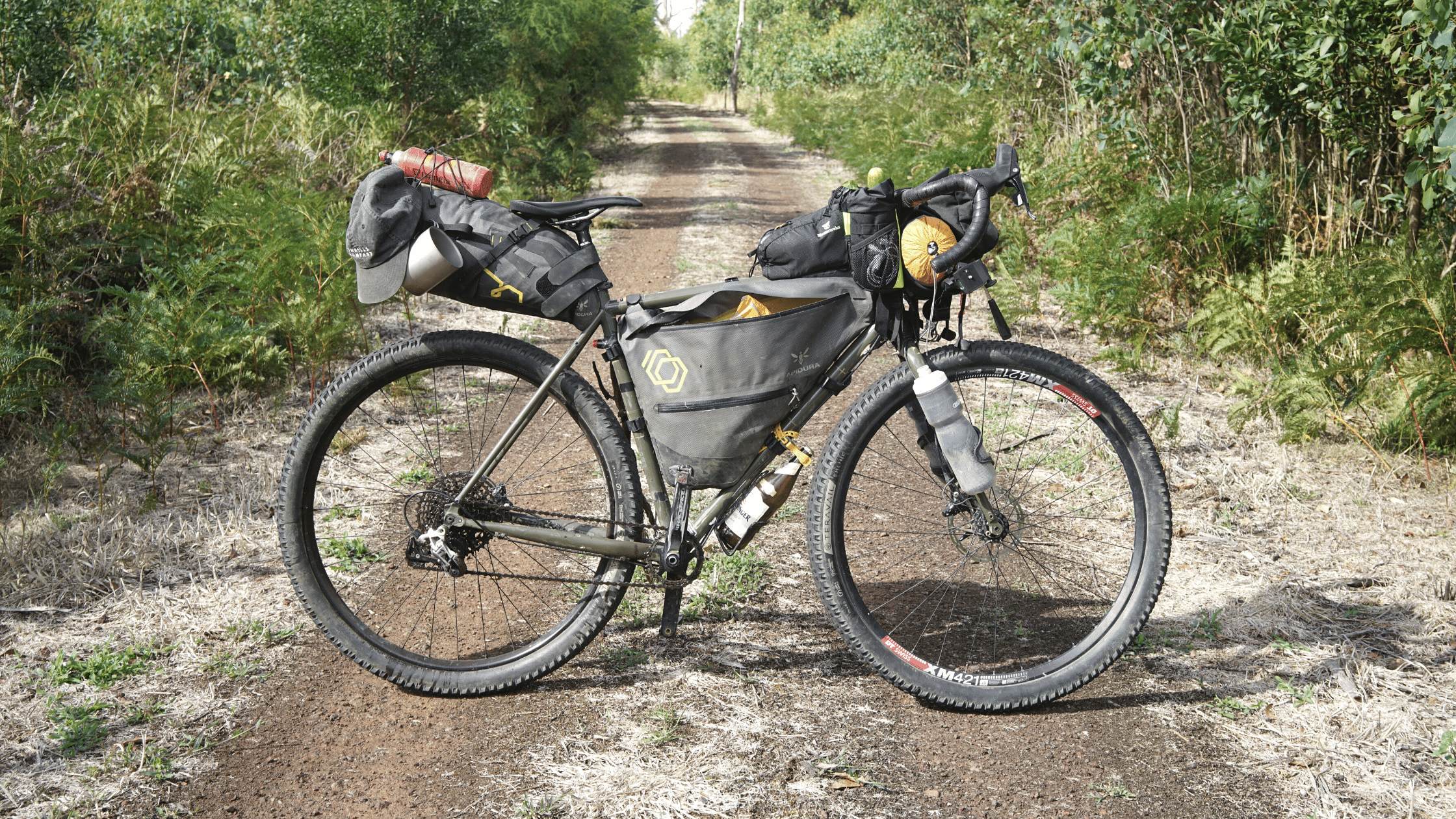
Throughout the last ten years, my cycling quests have led me across diverse landscapes and through numerous adventures, all atop bicycles with steel frames.
This material has consistently been by my side during these excursions, ultimately becoming my material of choice for adventure cycling.
WATCH MY REVIEW
Starting with journeys on a classic touring bike, moving through explorations on a Surly LHT, and presently adventuring with a Kona Sutra LTD, each of these steel companions has demonstrated its value.
With this extensive experience, I can assert with confidence that for durability, comfort, and peak performance, there’s no match for steel bikes.
Indeed, in the realm of adventure cycling, steel bikes stand out
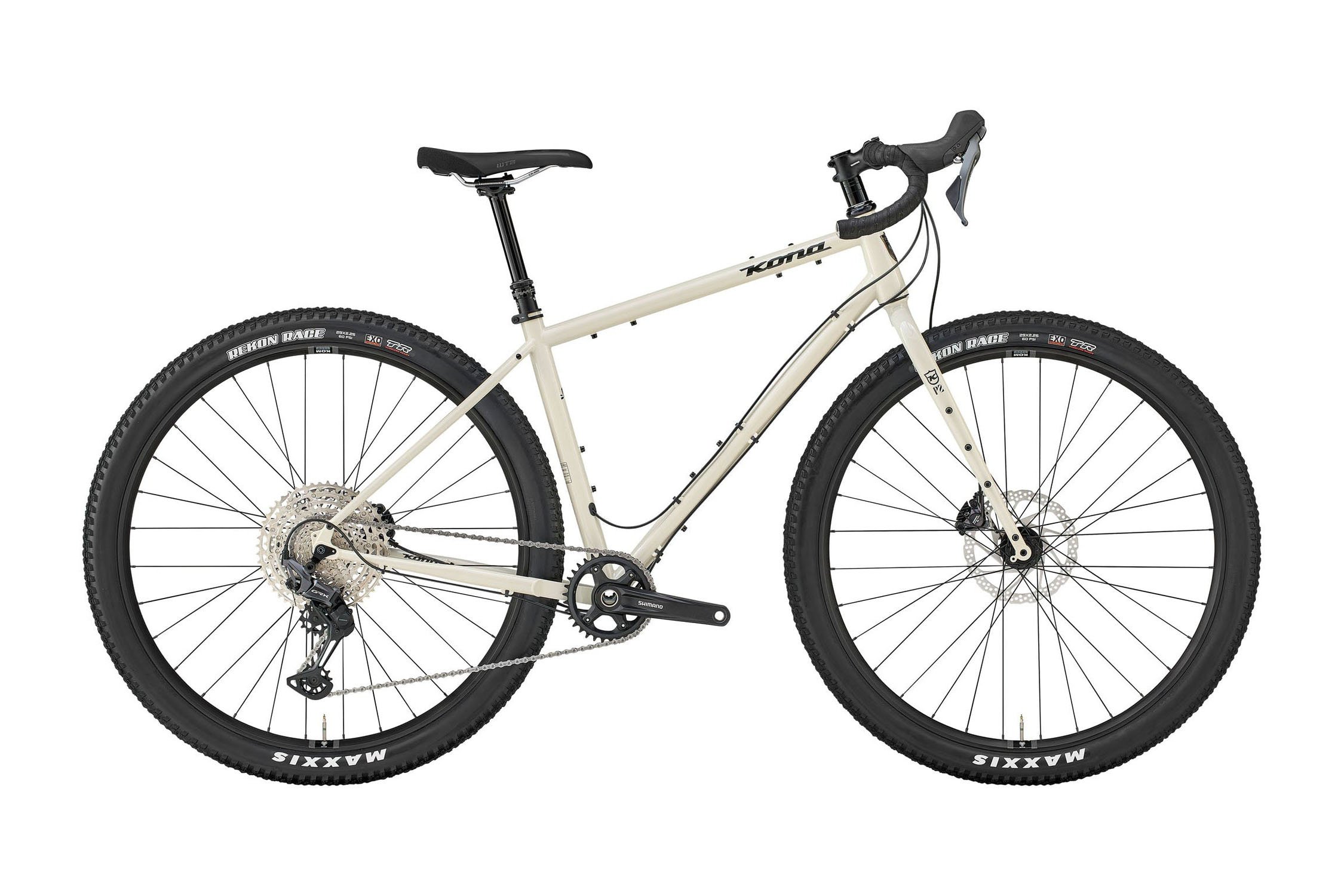
Kona Sutra LTD 2025 — A rugged steel adventure bike with 29×2.25″ tires, SRAM Rival 1×11 drivetrain, and a dropper post. Its stable geometry, endless mounting points, and smooth steel ride make it perfect for loaded bikepacking and off-road exploration.
Mason InSearchOf
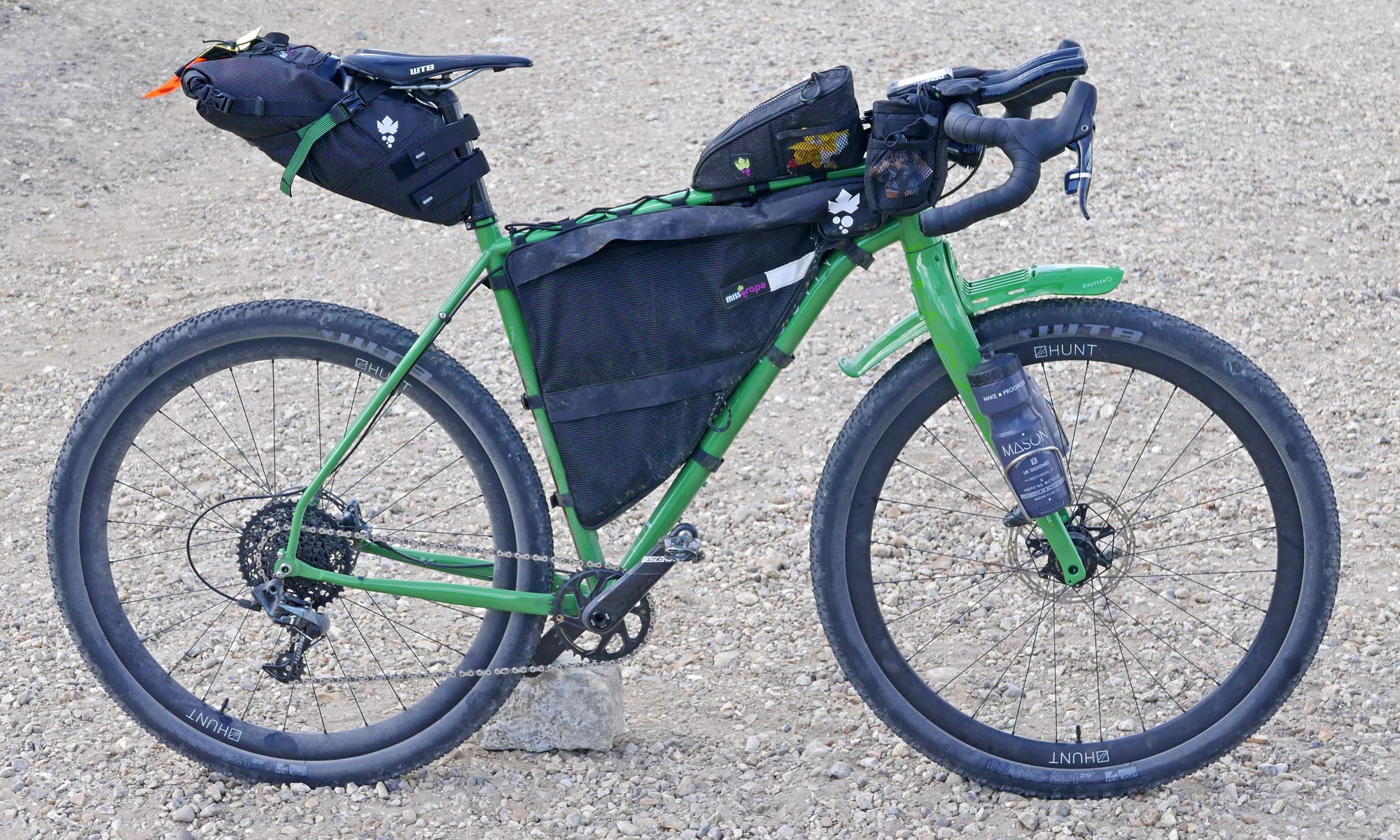
The Ultimate Steel Adventure Machine for Continent-Crushing Journeys
Proven in the world’s most demanding ultra-endurance races, this drop-bar mountain bike bridges the gap between gravel racing and true off-road capability with its massive tire clearance and bombproof steel construction.
Price: From $3,976 USD (Rival 1x build starts at $3,864)
Weight: 24.25 lbs (11 kg)
Frame/Fork Material: Frame – Custom-formed Progressive-butted Dedacciai ‘Zero’ Steel with Reynolds 853 seat tube. Fork – Mason Hot Shoes carbon fork with dynamo routing
Groupset & Drivetrain: Upper-Mid level builds available, starting with SRAM Rival 1x
Gear Ratios: 22″ to 94″ (climbing-focused to high-speed capability)
Geometry: Stack/Reach ratio 1.65 (Upright), Trail 73mm (High/Sluggish), Chainstay 445mm (Mid-Long/Chill), suspension-corrected for up to 100mm travel
Tire Clearance: 650b x 2.8″ or 29″ x 2.6″ maximum clearance – truly massive for a drop-bar bike
The Mason InSearchOf represents the pinnacle of steel adventure bike design, striking “a nice balance between gravel bike and mountain bike: it’s like a cross-country 29er designed for drops.” This isn’t just marketing hyperbole – Josh Ibbett, a previous winner of the prestigious Trans Continental race and one of the few people to have ridden around the world, has proven this bike’s capabilities in some of the world’s most demanding ultra-endurance events.
Josh completed the Tour Divide – the iconic 2,750-mile unsupported off-road race down the length of the USA – on his Mason InSearchOf, cementing this bike’s reputation in the ultra-endurance community. The frame’s construction using custom-formed Progressive-butted Dedacciai ‘Zero’ steel tubing provides the perfect blend of comfort and durability for multi-day adventures.
What sets the InSearchOf apart is its incredible versatility. The frame features extensive mounting options with ‘Anything Cage’ style bosses on both the top and underneath of the down tube, plus compatibility for racks, mudguards, and dynamo lighting systems. The unique ‘Mason Shutter’ front fender is designed specifically for this bike to “help protect the rider, packs and headset from dirt and water that get thrown off the big tyres in wet conditions,” proving invaluable on extended off-road journeys.
The Hot Shoes fork comes internally routed for dynamo light systems and includes all the mounting hardware you could need. With stealth dropper post compatibility and that massive tire clearance, you can run anything from fast-rolling 29×2.4″ tires for gravel racing to full 650b x 2.8″ rubber for serious off-road adventures.
However, it’s worth noting that Mason has evolved this design – the InSearchOf was first launched in 2019 and has now been updated to become the ISO2 in 2025, with “every detail re-examined and updated.” While the original InSearchOf established the template, riders considering this bike should investigate the newer ISO2 model for the latest refinements.
This is a bike that doesn’t just talk the talk – it’s been proven on some of the world’s most challenging routes. Whether you’re planning a multi-day bikepacking adventure, tackling technical singletrack, or need a do-everything machine that can handle anything from gravel roads to mountain bike trails, the InSearchOf delivers the capability and comfort to take you anywhere your ambitions lead.
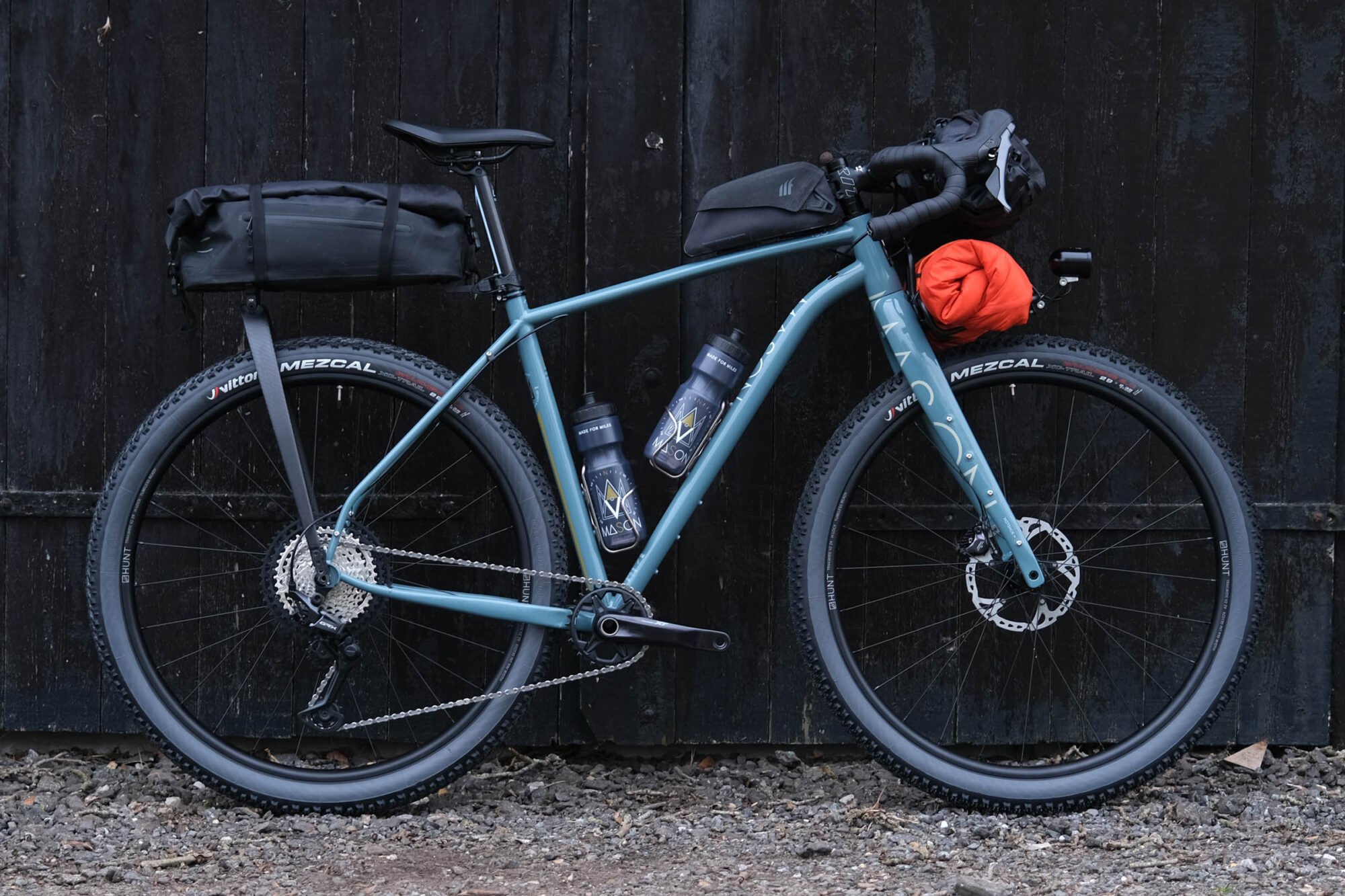
Mason InSearchOf is a steel drop-bar adventure bike proven in ultra-endurance events like the 2,750-mile Tour Divide. Its Dedacciai ‘Zero’ steel frame, Hot Shoes carbon fork, and huge 650b x 2.8″ or 29″ x 2.6″ clearance deliver unmatched off-road versatility. With extensive mounts, dynamo routing, and dropper compatibility, it’s built for serious bikepacking—now refined in the updated ISO2 for 2025.
Panorama Taiga EXP
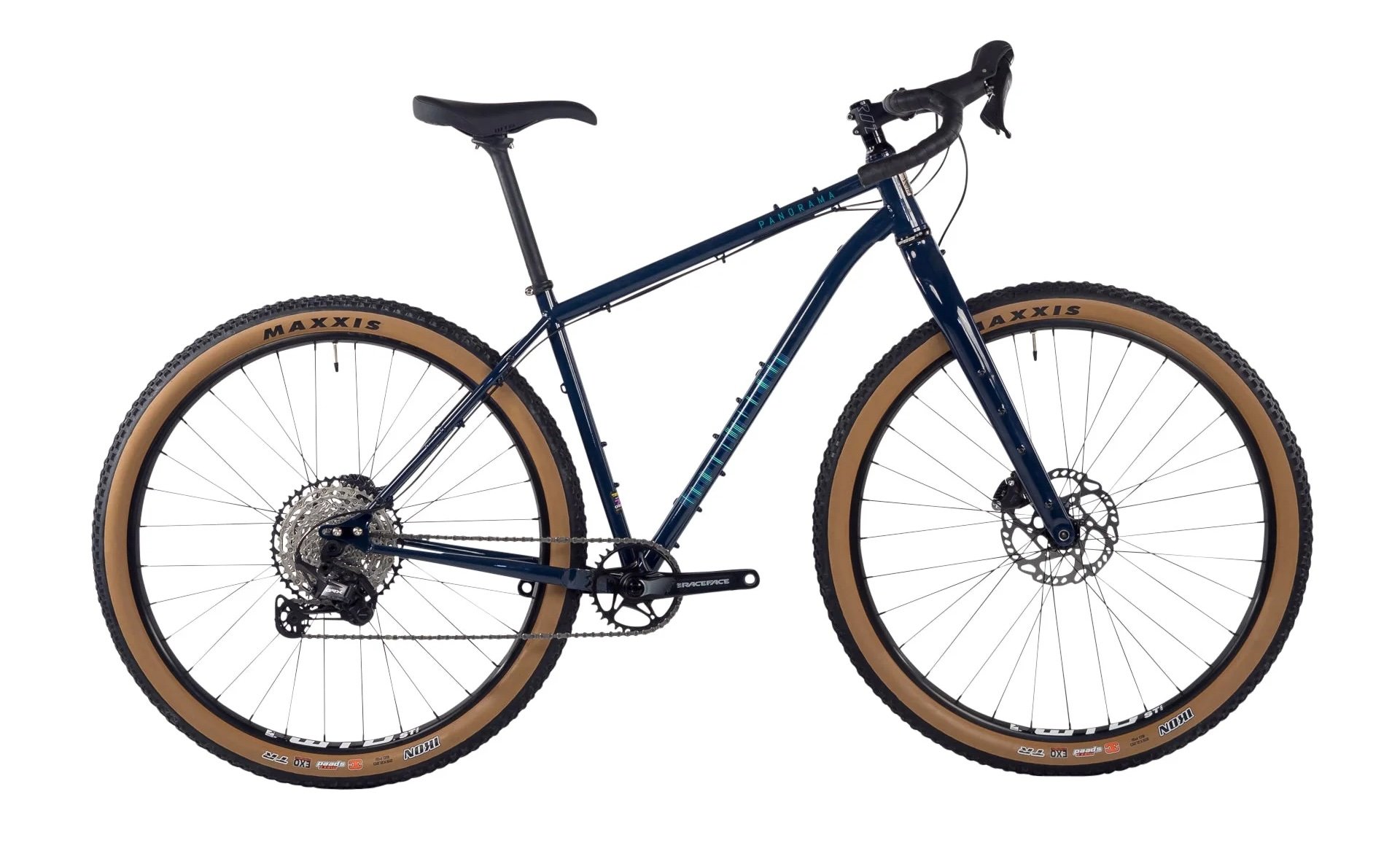
A Canadian-Made Steel Adventure Machine Built for Anything
A true do-it-all steel gravel bike that blurs the lines between adventure touring and singletrack capability. Built in Quebec with premium Reynolds 725 steel and designed for the most demanding expeditions.
Price: From $2,667 USD (about $3,600 CAD)
Weight: 25 pounds (11.34 kg)
Frame/Fork Material: Frame – Reynolds 725 Steel. Fork – Carbon Fiber with Internal Dynamo Routing
Groupset & Drivetrain: Gevenalle GX shifters, SRAM NX Eagle 12-speed drivetrain
Gear Ratios: 20″ to 90″ (Low climbing gear to high speed gear)
Geometry (M): Stack/Reach ratio – 1.67 (Very Upright), Chainstay 450mm (Long/Chill), Trail 95mm (High/Sluggish)
Tires and Wheel Sizes (Tire Clearance): HUNT XC Wide wheels with 29 x 2.25″ WTB Rangers. Max tire clearance 29×2.6″
The Panorama Taiga EXP represents the evolution of Canadian steel craftsmanship into the adventure cycling realm. This drop-bar version of Panorama’s acclaimed mountain bike brings serious off-road capability to the gravel world.
What sets the Taiga EXP apart is its uncompromising approach to versatility. The Reynolds 725 frame is packed with useful features: adjustable dropouts, split seat stay for belt drive and suspension fork compatibility, and dropper post routing, and tons of mounting points. The premium heat treated Reynolds 725 tubeset provides a significant upgrade over the generic 4130 chromoly found on many competitors.
I got the chance to meet Simon and Louise from Panorama in this video (Truly amazing people!)
The bike’s geometry strikes an impressive balance between comfort and capability. Tuned geometry to provide comfort and efficiency of a road handlebar with more space in the front triangle to fit a bigger frame bag, while maintaining the slack and stable handling characteristics needed for technical terrain.
Adventure-ready features abound: triple-pack mounts, downtube bosses, provisions for a bolt-on top tube bag, and internal cable routing for dynamo hub usage. The sliding dropouts offer flexibility for single-speed setups or belt-drive systems, while 100mm suspension fork capability opens up even more terrain possibilities.
The component specification is thoughtfully chosen for long-distance reliability. Gevenalle GX shifters provide the perfect blend of road ergonomics with mountain bike shifting precision, while the SRAM NX Eagle 12-speed drivetrain offers an impressive gear range for loaded touring. HUNT XC Wide wheels provide the strength needed for rough terrain, and Avid BB7 mechanical disc brakes ensure consistent stopping power with easy field maintenance.
Perfect for multi-week adventures like the Great Divide, the Taiga EXP is equally at home on technical singletrack as it is grinding out gravel miles. The combination of premium steel construction, thoughtful geometry, and extensive mounting options makes this bike a serious contender for anyone seeking a truly capable adventure machine.
The Panorama Taiga EXP proves that Canadian steel craftsmanship is alive and well, delivering a bike that’s ready for whatever adventure you can dream up.
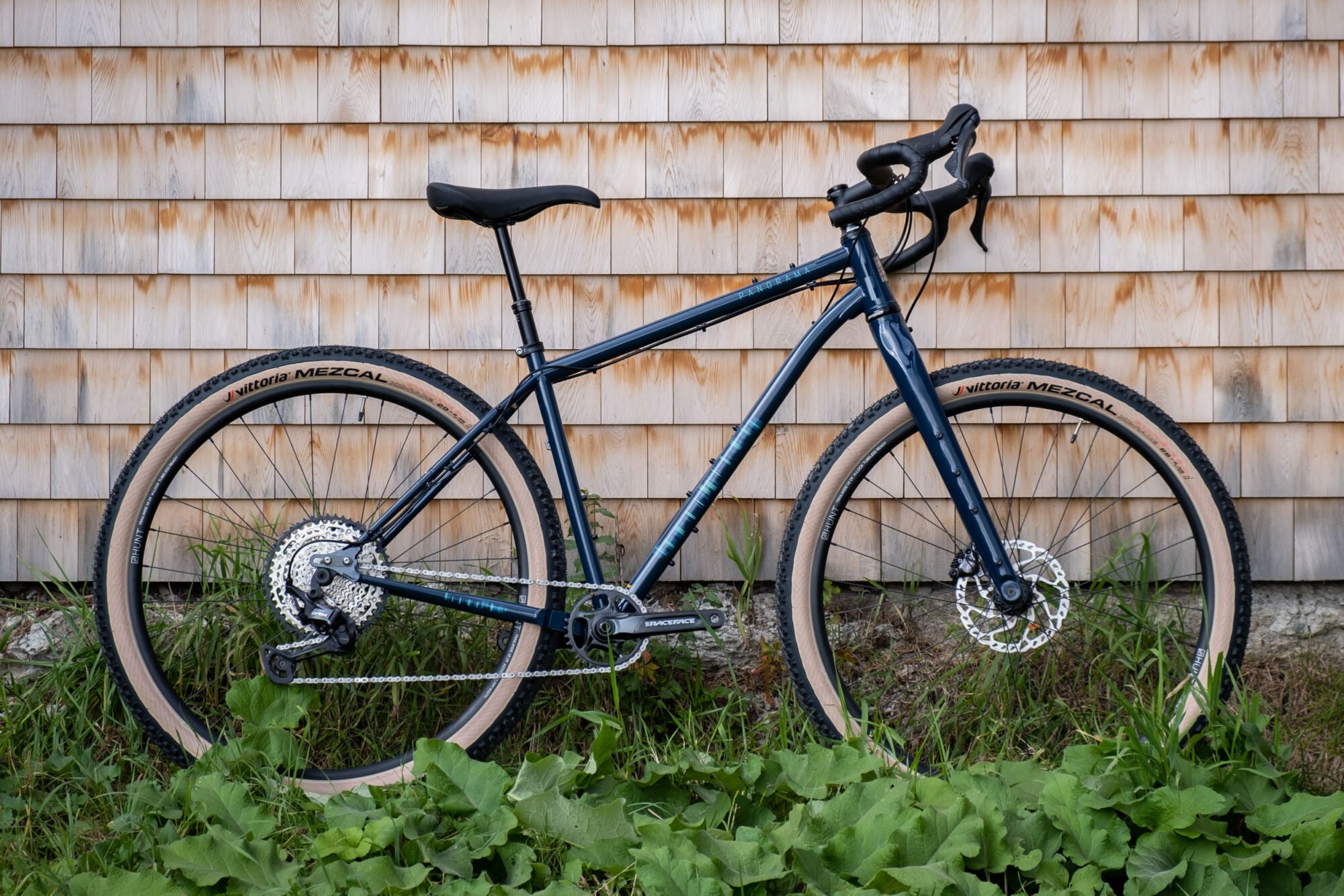
Panorama Taiga EXP is a Canadian-made Reynolds 725 steel adventure bike built for everything from gravel touring to technical singletrack. With 29×2.25″ tires (clearance to 2.6″), a carbon fork with dynamo routing, and features like sliding dropouts, belt-drive compatibility, and suspension fork support, it’s ready for any terrain. Extensive mounts, adventure-focused geometry, and a wide-range SRAM NX Eagle 12-speed drivetrain make it ideal for long, loaded expeditions.
Cotic Cascade
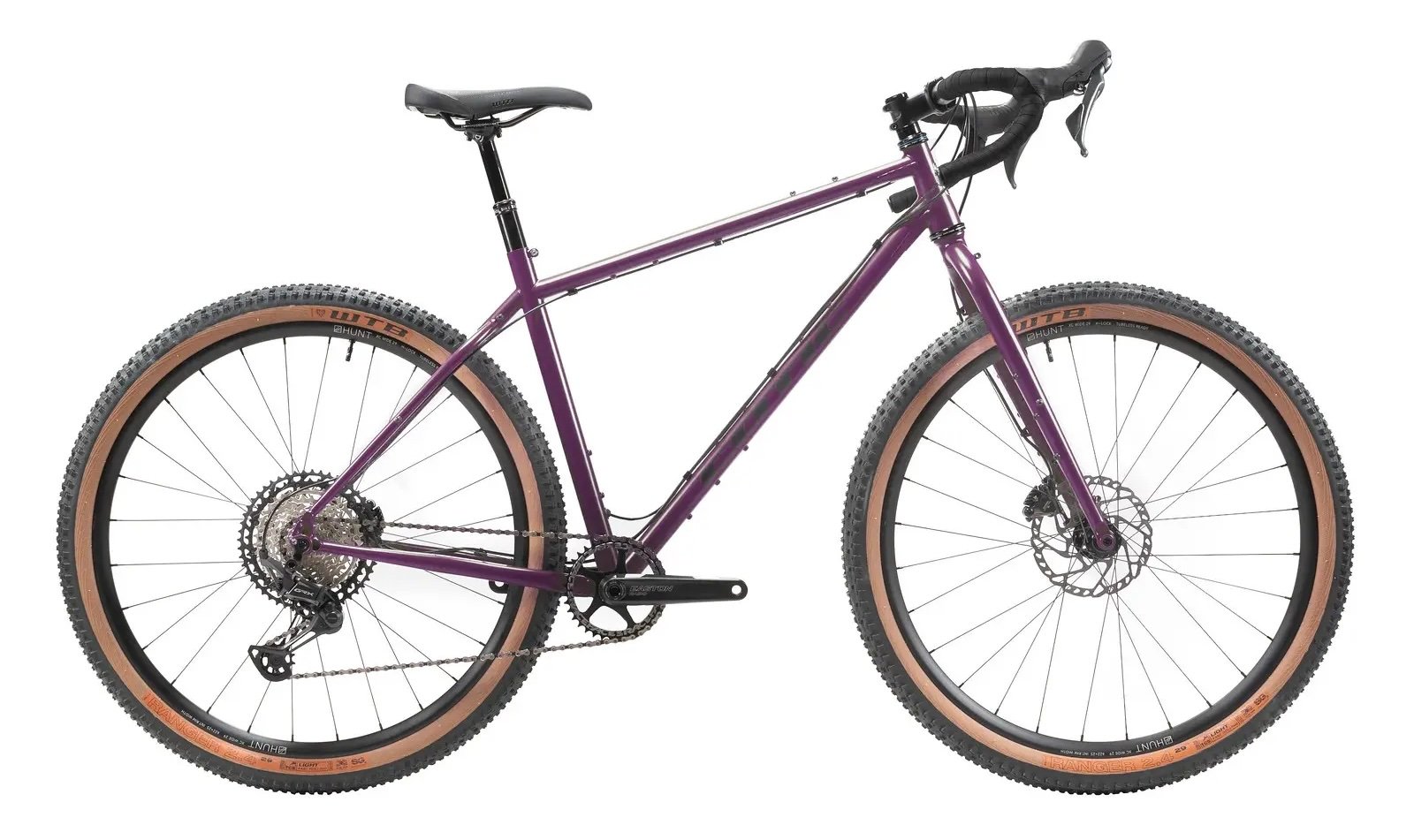
A Steel Drop-Bar Adventure Machine Built for Versatility
Rugged, confident, and supremely adaptable – this UK-made steel gravel bike bridges the gap between mountain bike capability and gravel bike refinement with its unique Sureshot geometry.
Price: £2,149 GBP (about $2,670 USD)
Weight: 10.5kg (23.2 lbs)
Frame/Fork Material: Frame – Reynolds 853 steel front triangle with Ovalform top tube, 4130 Chromoly wishbone stays. Fork – Cotic Alpaca steel disc fork (Carbon Salsa Firestarter or RockShox SID SL 100mm options available)
Groupset & Drivetrain: Shimano 1x drivetrain (various build options available)
Gear Ratios: 18″ to 93″ climbing gear range
Geometry (M): Stack/Reach ratio – 1.52, Chainstay 438mm, Trail 79mm (High), Front suspension compatible
Tires and Wheel Sizes (Tire Clearance): 29×2.4″ rear, 29×2.6″ front (also accommodates 27.5×2.8″/3.0″)
The Cotic Cascade recently won “Best Value” Gravel Bike of the Year Awards, and it’s easy to see why. This isn’t just another gravel bike – it’s a genre-bending adventure machine that combines the confidence of a mountain bike with the efficiency of a drop-bar setup. The 2025 models are being hand-made in small batches by Veloctopus in Portugal, ensuring exceptional build quality.
The Cascade’s party trick is its incredible versatility. You can spec it with a rigid steel fork for classic gravel duties, upgrade to a carbon fork for weight savings, or go full adventure mode with a 100mm suspension fork and dropper post. Framesets start from just £999 with the colour-matched steel fork, while complete drop bar bikes start from £2,149.
What sets this bike apart is Cotic’s signature “Sureshot geometry” – a longer reach design built around short stems that creates an incredibly stable and confident ride. The Reynolds 853 steel front triangle provides the perfect blend of compliance and durability, while the 4130 Chromoly wishbone stays add that distinctive Cotic rear-end feel.
The bike’s mountain bike DNA shows through in its handling characteristics. It’s playful and agile like a cross-country bike but with the stability you need for technical descents and challenging terrain. The generous tire clearances mean you can run proper knobby tires for serious off-road adventures or stick with gravel treads for mixed-surface riding.
Frame bag bosses, fender mounts, and multiple cargo mounting points make this a serious contender for bikepacking adventures. Whether you’re planning multi-day tours or just want a bike that can handle your daily commute and weekend trail adventures, the Cascade delivers that rare combination of fun and functionality.
In comparison to other adventure gravel bikes, the Cascade stands out for its distinctly British approach to steel bike building – it’s tough, reliable, and built to last decades rather than seasons. At £2,149 for the bronze build, it offers excellent value compared to similarly specced competitors, making serious adventure capability accessible without breaking the bank.
A confident, sure-footed steel adventure bike that thrives on technical terrain while remaining perfectly at home on long gravel rides. The Cascade proves that sometimes the best way forward is to take the path less traveled – preferably on the gnarliest trail you can find.
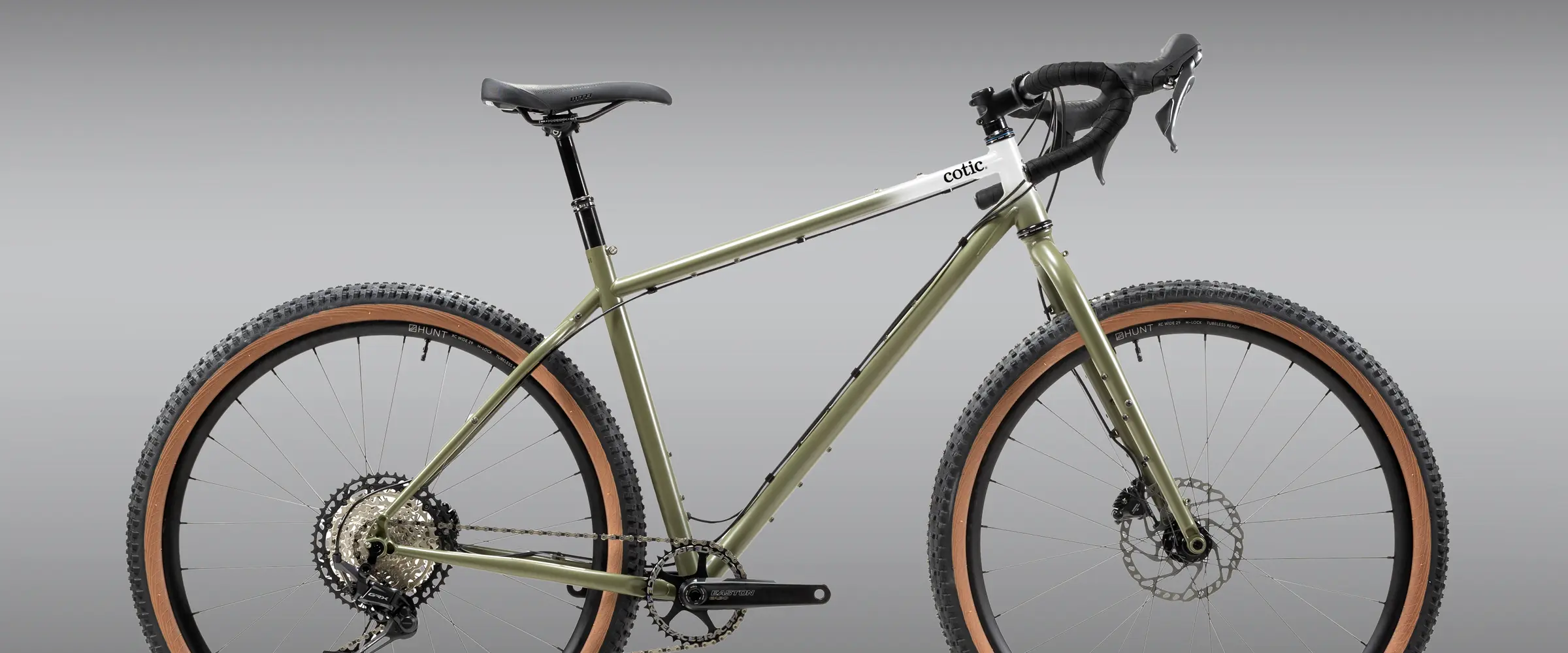
Cotic Cascade is a UK-made Reynolds 853 steel adventure bike with Sureshot geometry, blending mountain bike stability with gravel efficiency. It clears 29×2.4″ rear and 2.6″ front tires, supports rigid, carbon, or 100mm suspension forks, and is packed with mounts for bikepacking. With playful handling, long-term durability, and versatile build options, it’s equally at home on technical singletrack or multi-day gravel tours.
Bombtrack Beyond SUS
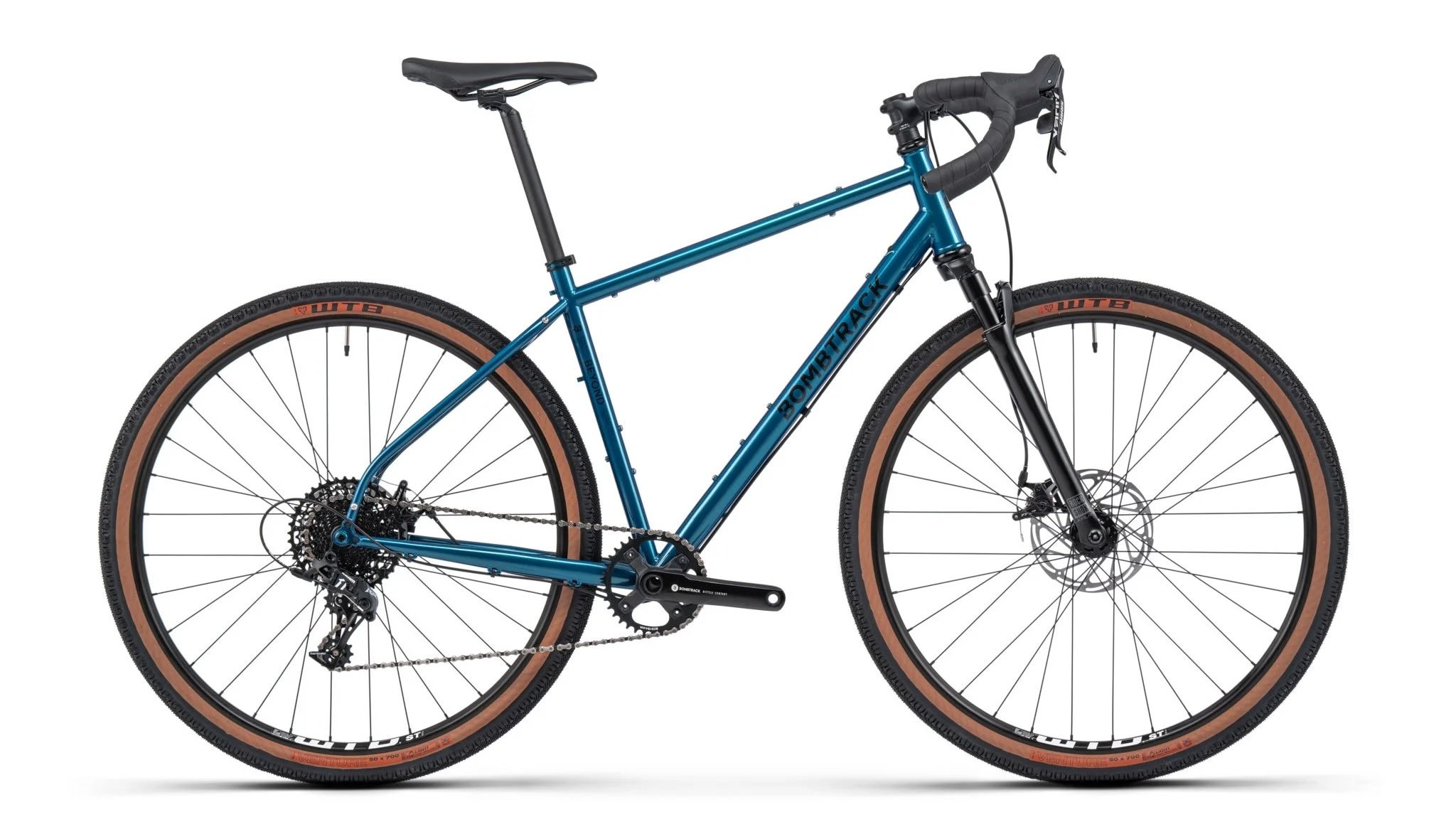
A German-Engineered Steel Adventure Machine with Suspension
Smooth-riding, cargo-ready, and built to explore beyond the beaten path. This Cologne-crafted steel gravel bike combines traditional frame durability with modern suspension technology and versatile mounting options.
Price: $2,789 USD (2,699€)
Weight: 27 pounds (12.25 kg)
Frame/Fork Material: Frame – 4130 double-butted chromoly steel. Fork – RockShox Rudy XPLR suspension, 40mm travel
Groupset & Drivetrain: SRAM Apex 1×11, 11-42T cassette with wide range gearing
Gear Ratios: 25″ to 95″ (0.90 to 3.43 ratio)
Geometry (M): Stack/Reach ratio – 1.60 (upright), chainstay 455mm (stable), trail 75mm (high/stable)
Tires and Wheel Sizes (Tire Clearance): WTB Venture Light on tubeless-ready WTB ST i23 rims, max clearance 2.1″
The Bombtrack Beyond SUS represents a thoughtful approach to adventure cycling, bridging the gap between traditional touring bikes and modern gravel machines. Thanks to the RockShox Rudy suspension fork, no surface will shake, rattle, or roll you while riding the Beyond SUS, making it an exceptional choice for riders seeking comfort on rough terrain without sacrificing cargo capacity.
From Cologne’s renowned Bombtrack workshop comes this distinctive steel adventure bike that stands apart in the crowded gravel market. The Beyond SUS isn’t just another gravel bike with a suspension fork slapped on – it’s a carefully engineered platform designed for serious adventure riding and bikepacking.
The heart of this machine is its 4130 double-butted chromoly steel frame, which provides the perfect balance of durability, comfort, and repairability for long-distance adventures. The frame features top tube mounts, triple cage mounts on the downtube and even underneath, so you can fit your cargo in your desired configuration. This level of versatility makes it a genuine expedition bike, capable of carrying everything from overnight essentials to multi-week touring loads.
What sets the Beyond SUS apart from traditional touring bikes is its modern gravel-focused geometry and that crucial RockShox Rudy XPLR fork. The RockShox Rudy XPLR fork with adjustable 40 mm travel transforms rough gravel roads and technical terrain into manageable, comfortable riding surfaces. This isn’t a gimmick – the suspension genuinely improves control and reduces fatigue on extended rides over challenging surfaces.
The SRAM Apex 1×11 drivetrain provides reliable shifting with a wide gear range suitable for loaded touring and steep climbs. The 11-42T cassette offers excellent climbing gears while still providing enough top-end for fast descents and tailwind sections. Tubeless-ready WTB ST i23 rims with WTB Venture Light tyres roll fast and smooth, while the option to run up to 2.1″ tires means you can adapt the bike for different terrain conditions.
Build quality reflects Bombtrack’s German engineering heritage, with attention to practical details that matter on long rides. Bombtrack Tau 12mm through-axle hubs means you will tackle trail-side repairs in a flash – a crucial consideration for remote adventure riding where reliability and repairability are paramount.
The upright geometry (1.60 stack/reach ratio) provides comfort for long days in the saddle while maintaining excellent handling characteristics. The longer chainstays (455mm) contribute to stable handling when loaded, making this bike predictable and confidence-inspiring whether you’re navigating technical singletrack or grinding out miles on rough gravel roads.
At $2,789, the Beyond SUS positions itself in the premium adventure bike category, but the combination of steel durability, suspension comfort, and extensive cargo mounting options justifies the investment for serious adventure cyclists. Available in five sizes from XS to XL, it accommodates a wide range of riders.
This is a bike built for riders who understand that adventure cycling isn’t just about speed – it’s about capability, comfort, and the confidence to explore wherever curiosity leads. The Bombtrack Beyond SUS delivers on all fronts, making it an outstanding choice for anyone seeking a truly versatile adventure companion that can handle everything from daily commuting to transcontinental expeditions.

Bombtrack Beyond SUS is a German-engineered 4130 chromoly steel adventure bike with a RockShox Rudy XPLR 40mm suspension fork for comfort and control on rough terrain. It clears up to 2.1″ tires, has extensive cargo mounts, and features upright, stable geometry for loaded touring. With a SRAM Apex 1×11 drivetrain, tubeless-ready wheels, and expedition-ready durability, it’s built for serious bikepacking and multi-surface exploration.
Mason Exposure
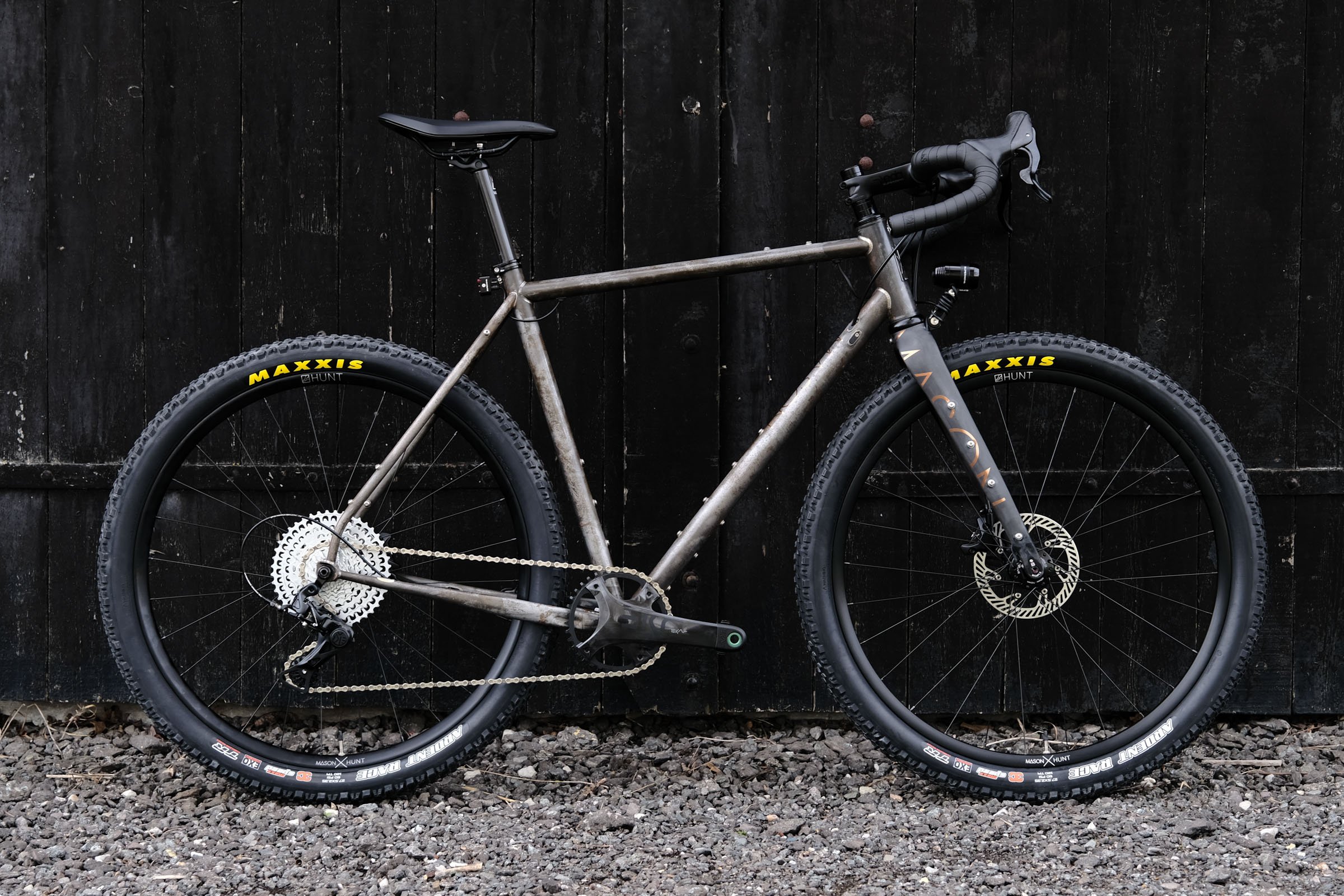
The Steel Reinterpretation of Adventure Gravel Excellence
A masterfully crafted steel adventure bike that bridges the gap between conventional gravel and expedition touring, offering sublime ride quality with exceptional versatility for long-distance multi-surface adventures.
Price: £2,150 ($2,600 USD) frameset only, complete builds from £4,500+ ($5,500+ USD)
Weight: Approximately 10-11kg (22-24 lbs) complete build depending on specification
Frame/Fork Material: Frame – Custom Dedacciai Zero/Zero Uno progressively butted steel with phosphate coating. Fork – Mason RangeFinder AS full carbon with 50mm offset
Groupset & Drivetrain: Available with Shimano GRX 810/815, SRAM Rival AXS, or Campagnolo Ekar builds
Gear Ratios: Varies by build – typical 1x setup offers 32t chainring with 10-44t or 10-52t cassette
Geometry (56cm): Stack/Reach ratio – 1.55, chainstay 435mm – wheelbase 1,043mm – head tube angle 70.5° – trail 71.1mm – fork offset 50mm. Bottom bracket drop 75mm
Tires and Wheel Sizes (Tire Clearance): 700c x 50mm or 650b x 58mm (2.35″) maximum. With fenders: 700c x 45mm or 650b x 55mm
The Mason Exposure represents the pinnacle of steel adventure bike design, engineered for “fast, long-distance and multi-month adventure touring over very variable and unpredictable terrain.” This bike bridges the gap between conventional gravel and oversized adventure touring with a sublimely smooth yet light and lively steel ride that proves why the oldest frame material can still match any modern material when done right.
Built using a custom-shaped, progressively butted, phosphate-coated Dedacciai Zero Uno tubeset engineered specifically for long range riding, the Exposure combines class-leading toughness and weight with engaging pedalling feel, ride quality and efficiency. The frame is 100% Italian TIG-welded and silver-brazed, representing the finest in European craftsmanship through Mason’s collaboration with renowned framebuilder Cicli Barco.
Compared to Mason’s aluminum Bokeh, the Exposure features a slacker 70° head tube angle, 10mm more stack height, shorter reach, and marginally more bottom bracket drop, providing stability, predictable handling when loaded with gear, and comfort over long distances. Reviewers consistently praise it as a “multi-purpose steel masterpiece” with geometry that’s considered but not obviously radical, offering an aesthetic and practical masterpiece for those who appreciate steel tubing and somewhere to bolt any accessory imaginable.
The Exposure truly excels in its versatility and mounting options. It features an extraordinary array of mounting points: 4 down tube (top side), 3 down tube (underneath), 3 seat tube, 2 top tube, and 2 seat stays (both sides) for bottles and accessories, plus dedicated silver-brazed rack mount eyelets and triple accessory mounts on the RangeFinder AS fork. This makes it exceptionally well-suited for bikepacking, touring, and adventure riding where carrying capacity is crucial.
The custom Mason RangeFinder AS carbon fork is specifically tuned for the Exposure, featuring pannier and rando-style rack mounts, internal brake and dynamo light routing, and massive tire clearance. The frame accommodates both 700c and 650b wheel sizes, allowing riders to optimize their setup for different terrain types – from fast hardpack sections to technical off-road adventures.
What sets the Exposure apart is its refined ride quality that “makes you feel good even when tired,” combined with practical features like T47 bottom bracket threading for internal cable routing, stainless steel threaded rear mudguard mounts, and compatibility with the Universal Derailleur Hanger standard for future-proofing.
This is the bike for riders who want the soul and comfort of steel but don’t want to compromise on modern performance and functionality. Whether you’re planning multi-week expeditions, weekend gravel adventures, or daily commuting, the Mason Exposure offers the versatility and quality to excel across all scenarios. It’s particularly compelling for those who appreciate traditional craftsmanship merged with contemporary engineering and want a bike that can genuinely do it all.
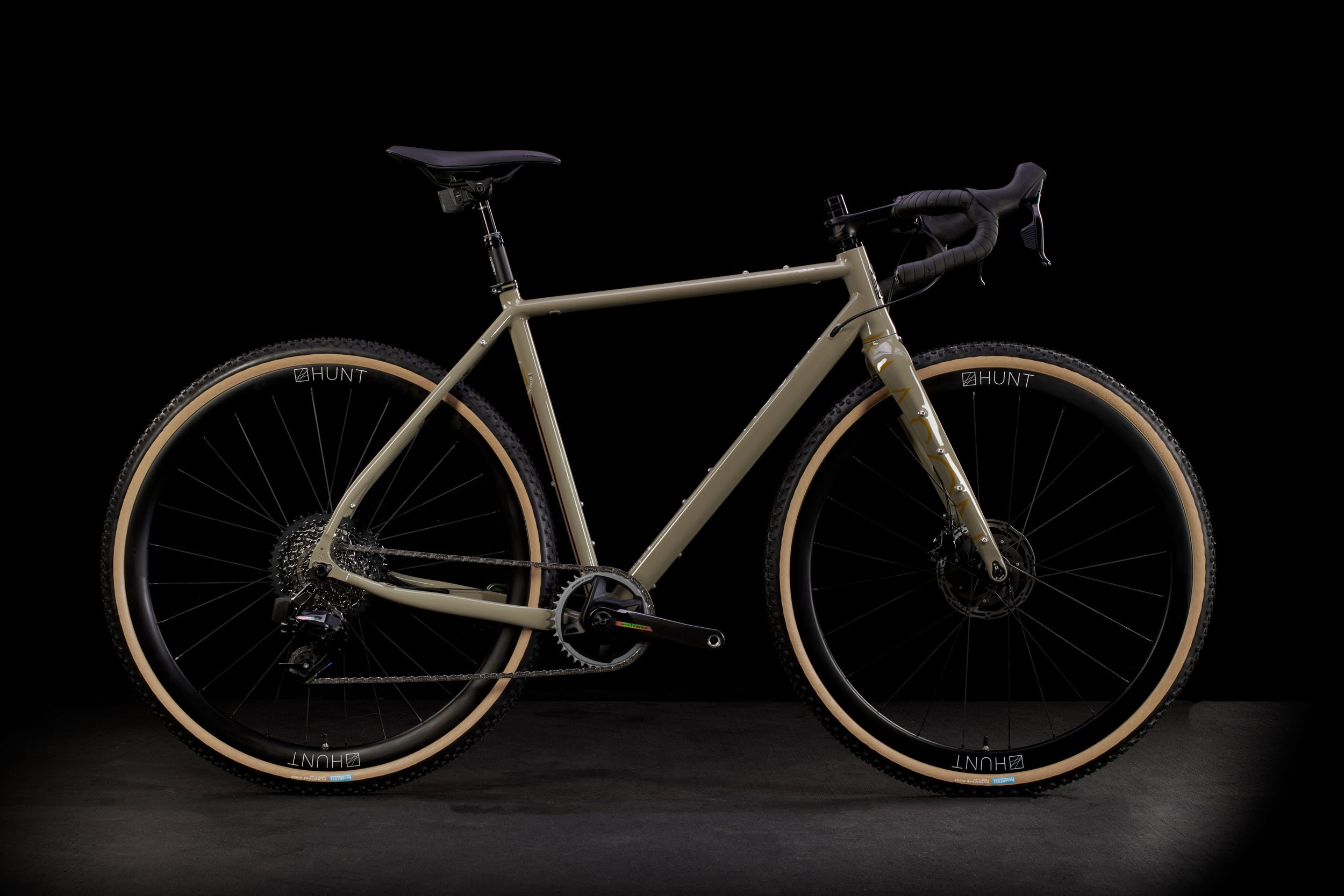
Mason Exposure is a high-end steel adventure bike built from custom Dedacciai Zero/Zero Uno tubing with a Mason RangeFinder AS carbon fork. It clears up to 700×50mm or 650b×58mm tires (slightly less with fenders) and features extensive rack, fender, and bottle mounts for expedition touring. With stable, comfortable geometry and options for Shimano GRX, SRAM Rival AXS, or Campagnolo Ekar builds, it blends classic steel ride quality with modern versatility for long-distance, multi-surface adventures.
Fairlight Cycles Faran 3.0
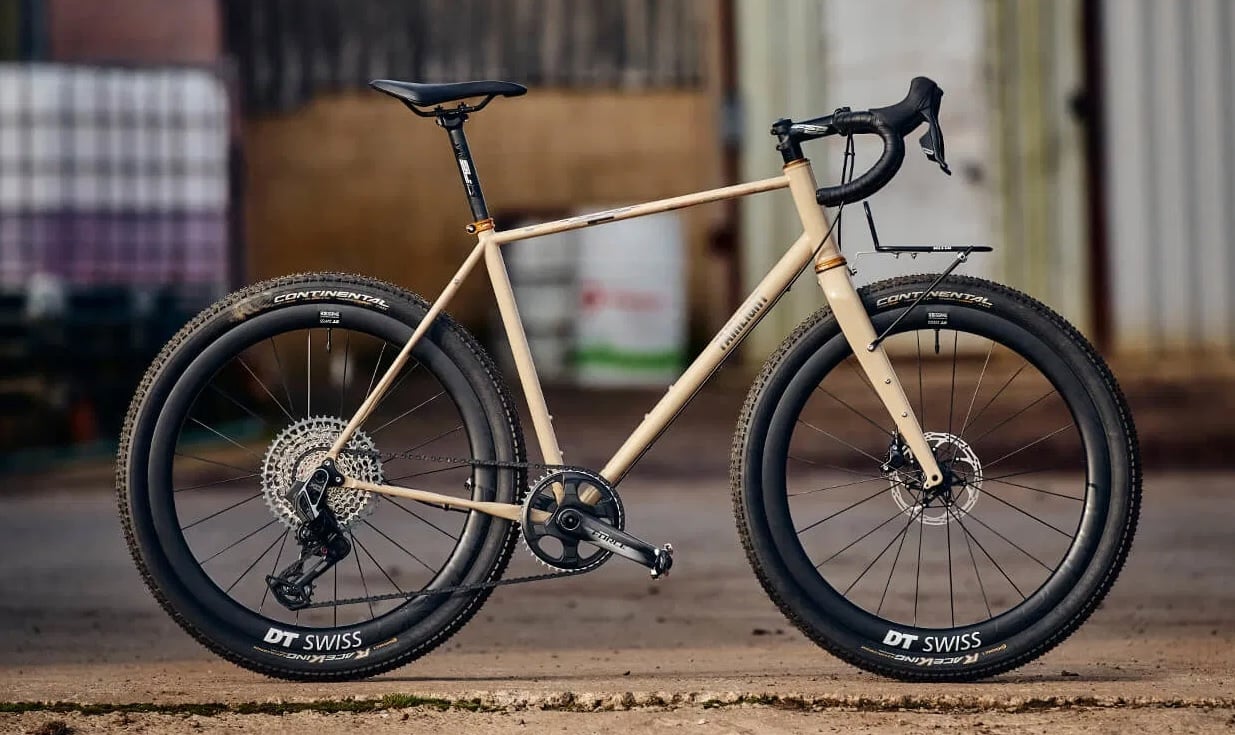
The Ultimate Steel Adventure Companion with Enhanced Capability
A refined all-steel touring and gravel machine that blends traditional craftsmanship with modern adventure bike versatility. Built for everything from daily commuting to loaded touring expeditions.
Price: From £2,099 (Starting price for frameset, complete builds vary)
Weight: Approximately 11-13kg depending on build (24-28 lbs)
Frame/Fork Material: Frame – Reynolds 725 front triangle with custom butting profiles, Reynolds 725 DZB downtube. Fork – All-steel Fairlight Faran 3.0 fork
Groupset & Drivetrain: Available with various builds including Shimano GRX 2×11 (46/30T crank with 11-34T cassette) or 1x options
Gear Ratios: Wide range available depending on build – low gearing optimized for loaded touring
Geometry (56cm): Stack/Reach optimized for comfort, 432mm chainstay, mid-low trail geometry for stability with front loads
Tires and Wheel Sizes (Tire Clearance): Massive clearance – up to 700c x 53mm or 650B x 62mm. Compatible with both wheel standards
The Faran 3.0 represents the evolution of Fairlight’s beloved adventure touring platform, now refined to handle even bigger tires and heavier loads. The Faran chassis has undergone a series of refinements for version 3, transforming it into one of the most capable steel adventure bikes available.
What sets the Faran 3.0 apart is its incredible versatility and attention to practical details. The all-new Fairlight Faran 3.0 frames arrive soon with significant improvements including increased tire clearance. Now compatible with up to 700 x 53mm and up to 62mm in 650B/27.5″. This massive tire clearance opens up possibilities for everything from smooth road touring to aggressive off-road adventures.
The frame construction showcases Fairlight’s commitment to both performance and durability. A Reynolds 725 front triangle with custom butting profiles. Reynolds 725 DZB downtube and a new 28.6mm top tube, ovalized to 25 × 32mm, for increased stability when carrying a front load demonstrates the thoughtful engineering behind this machine. The rear triangle benefits from lessons learned across Fairlight’s range, featuring heavily curved and flattened stays to maximize compliance. Unique to Fairlight.
For the mechanically inclined, the Faran 3.0 introduces impressive utility features. Dropper post compatible with 1x set-ups adds modern mountain bike capability, while the 3D-printed bottom bracket cable guide for mechanical gear set-ups shows attention to cable routing and maintenance access.
Previous generations of the Faran have earned praise for their versatility. It’s been a gravel bike for day excursions. It’s been a road bike, with narrower tyres. It’s had mountain bike tyres and road bike tyres and semi-slick gravel tyres, and it’s been fitted with 650B and 700C wheels, and through all that it’s been an excellent companion on the tarmac and off it.
The Faran 3.0 maintains the practical mounting points that made its predecessors so popular among touring cyclists and bike packers, with extensive rack compatibility and thoughtful accessory mounting. We re-analyzed all the boss and braze-on locations and re-positioned them to offer a better fit with a wider variety of racks and cages.
Available in Moss, Black, and Burnt Orange colorways, the Faran 3.0 represents the pinnacle of steel adventure bike design. Whether you’re planning a cross-continental tour, daily commuting, or weekend gravel adventures, this machine adapts to meet your needs while providing the smooth, comfortable ride quality that only comes from expertly crafted steel tubing.
A true do-everything bike that doesn’t compromise on capability or quality, built by a brand that understands what serious cyclists need from their adventure companion.
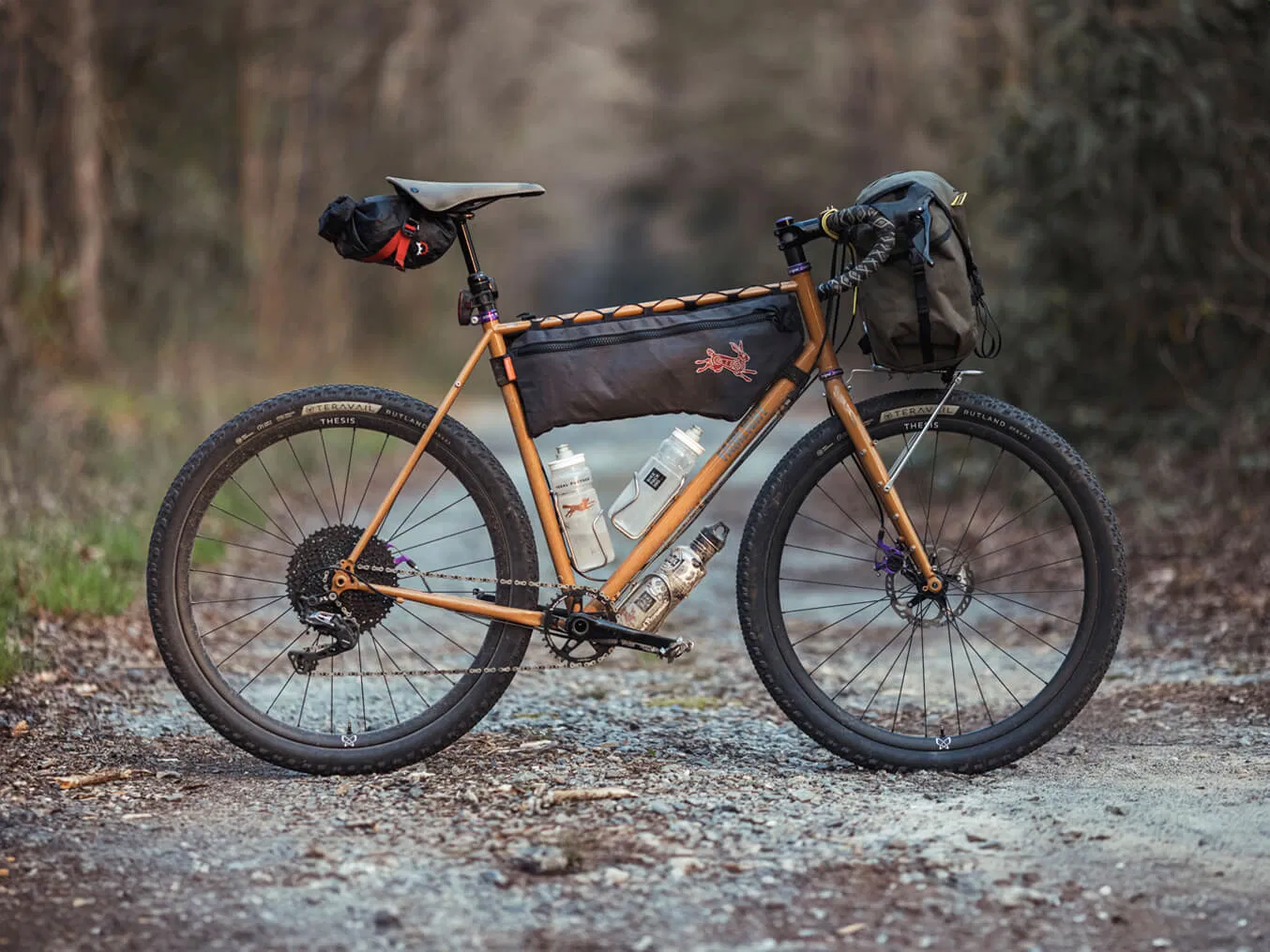
Fairlight Faran 3.0 is a versatile Reynolds 725 steel touring and gravel bike with clearance for up to 700×53mm or 650b×62mm tires. Designed for stability under load, it features extensive rack and cage mounts, dropper post compatibility, and refined tubing for strength and comfort. With multiple build options, it excels at everything from daily commutes to cross-continental bikepacking adventures.
Surly Bridge Club
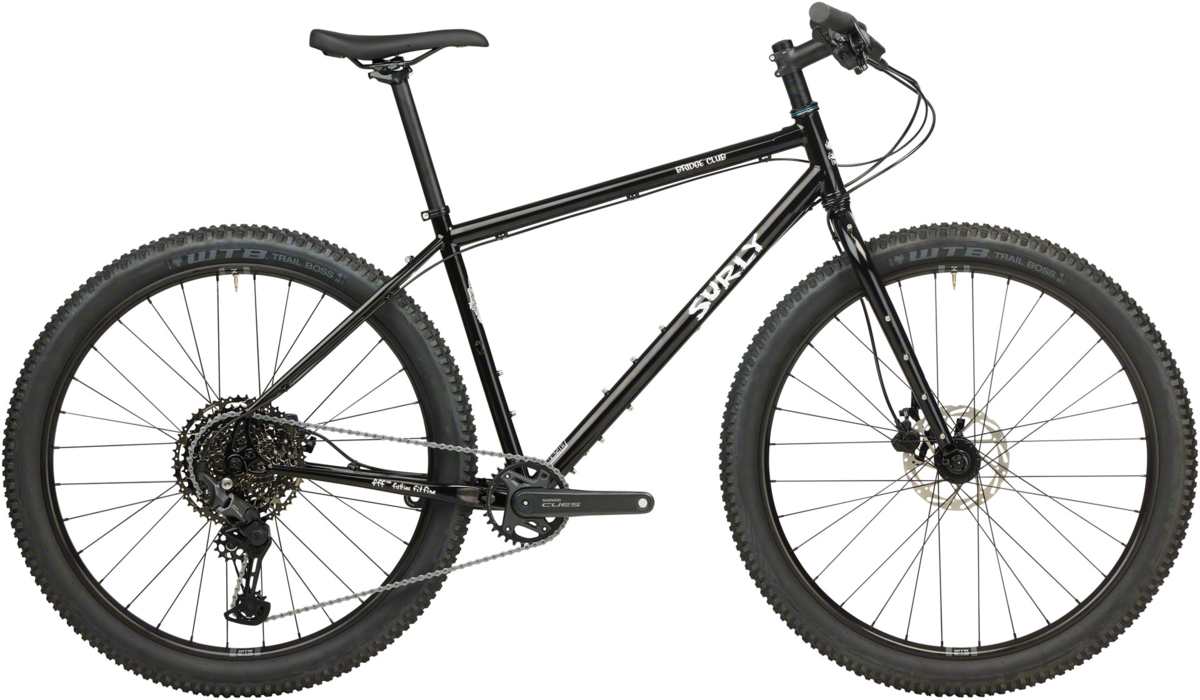
The Underrated Multi-Surface Adventure Machine
A rugged, versatile dirt touring bike that bridges the gap between traditional touring and modern gravel adventure. Built for riders who refuse to be limited by surface type.
Price: $1,499 USD (about $2,346 AUD)
Weight: 15kg (33 lbs)
Frame/Fork Material: Frame – 4130 Chromoly, Natch tubing, double-butted main triangle, TIG welded, ED coated. Fork – Surly Cocktail Fork, 4130 Chromoly, double-butted tapered fork blades
Groupset & Drivetrain: Shimano Deore 11-speed, 32t single chainring and Shimano Deore 11-51t cassette
Gear Ratios: 16.8″ to 78.5″ (0.61 to 2.84 ratio)
Geometry (M): Stack/Reach ratio – 1.38, chainstay 435mm – wheelbase 1,073mm – headtube angle 71° – trail 67mm – Fork offset 45mm. Bottom bracket drop 60mm
Tires and Wheel Sizes (Tire Clearance): 27.5 x 2.4″ With a max tire clearance of 26 x 3.0″, 27.5 x 2.8″, or 700c x 47mm (with or without fenders)
The Surly Bridge Club represents a refreshing take on the dirt touring concept, challenging the notion that you need skinny tires for long-distance adventures. This bike is “ultra-focused on simplicity, it only has the barnacles that matter most to the discerning bike tourist” and proves that versatility doesn’t have to come at the expense of reliability.
What sets the Bridge Club apart in the gravel and touring world is its unique approach to wheel size compatibility. The frame offers clearance for “700 x 47mm tires (with or without fenders), 27.5 x 2.8″ tires (27.5 x 2.6″ with fenders), and 26 x 3″ tires (26 x 2.8″ with fenders)”, making it one of the most adaptable platforms available. This means you can run anything from traditional touring setups to fat bike-style adventures on the same frame.
The single-speed drivetrain philosophy keeps things mechanically simple while the wide-range 11-51t cassette ensures you’ll have the right gear for steep climbs with a loaded bike. As cyclists note, “It’s a long-distance hauler that also performs well when bombing MTB trails”, highlighting its dual-purpose nature that many gravel bikes struggle to achieve.
The bike is designed to “run racks and panniers, framebags, or all of the above”, making it equally at home on a cross-country tour or a weekend bikepacking adventure. The chromoly steel construction with ED coating provides the durability needed for rough roads while maintaining the compliance that makes long days in the saddle comfortable.
Perhaps most importantly for the gravel scene, the Bridge Club challenges the industry’s obsession with lightweight carbon and racing geometry. Its geometry figures “don’t deviate much from the Canyon Grail CFR” despite looking completely different, proving that a touring-oriented steel bike can deliver similar positioning to dedicated gravel racers.
This is a bike for riders who want to explore beyond the beaten path without worrying about mechanical complexity or terrain limitations. As Surly puts it, the Bridge Club “can evenly navigate the backwoods and single lane highways so you can go anywhere” – and that’s exactly what makes it such a compelling option in the increasingly crowded gravel market.
The Bridge Club isn’t trying to be the fastest or lightest bike in the category. Instead, it’s built for those who value reliability, versatility, and the freedom to take any route that looks interesting. In a world of increasingly specialized bikes, the Bridge Club’s jack-of-all-trades approach feels refreshingly honest and practical.
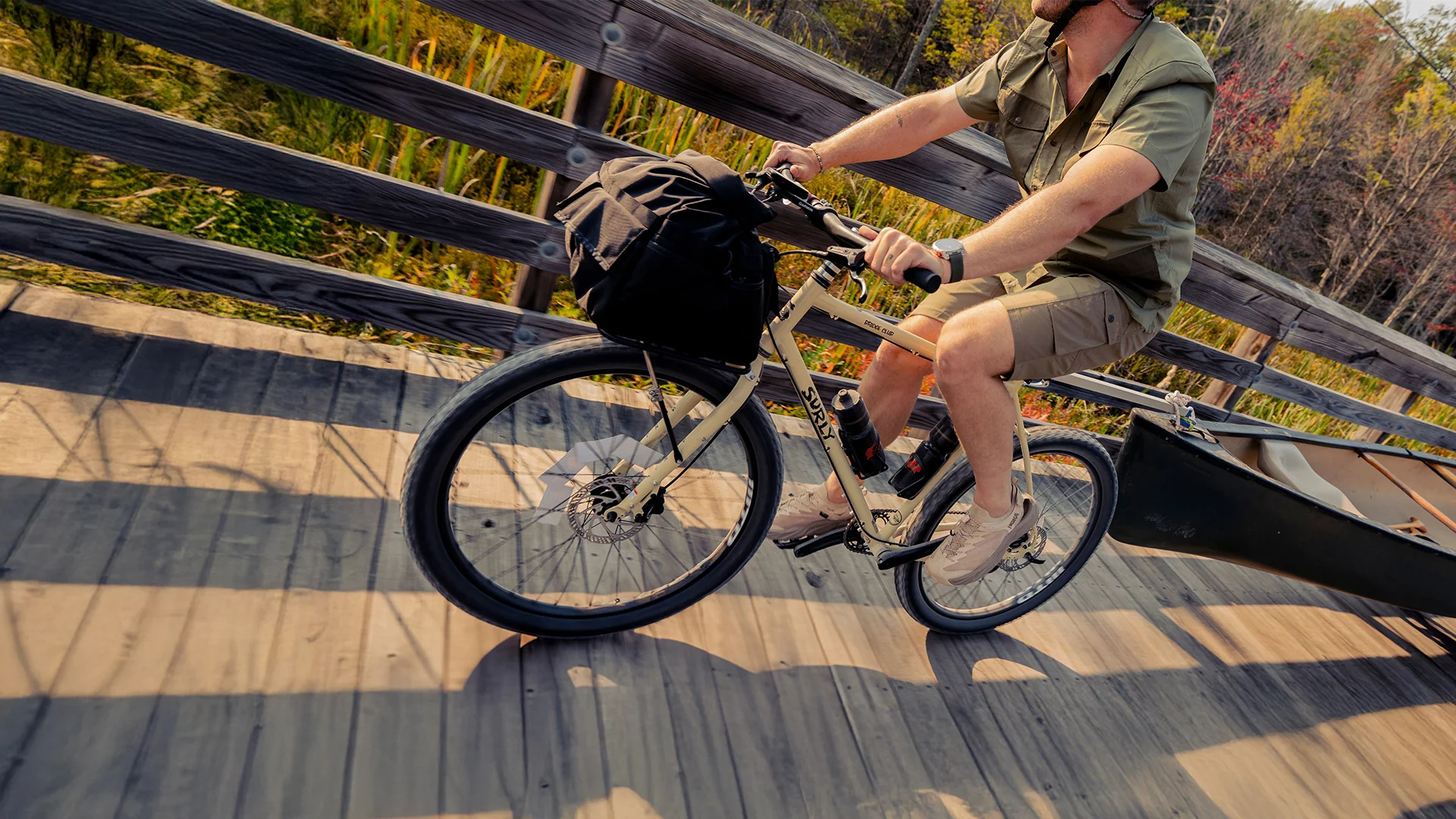
Surly Bridge Club is a rugged 4130 chromoly steel dirt touring bike with clearance for 26×3.0″, 27.5×2.8″, or 700×47mm tires. Its versatile geometry, wide-range Shimano Deore 1×11 drivetrain, and extensive rack and bag mounts make it equally suited to cross-country tours or weekend bikepacking. Built for reliability and all-surface capability, it’s a true go-anywhere, do-anything adventure machine.
Cinelli HOBOOTLEG GEO
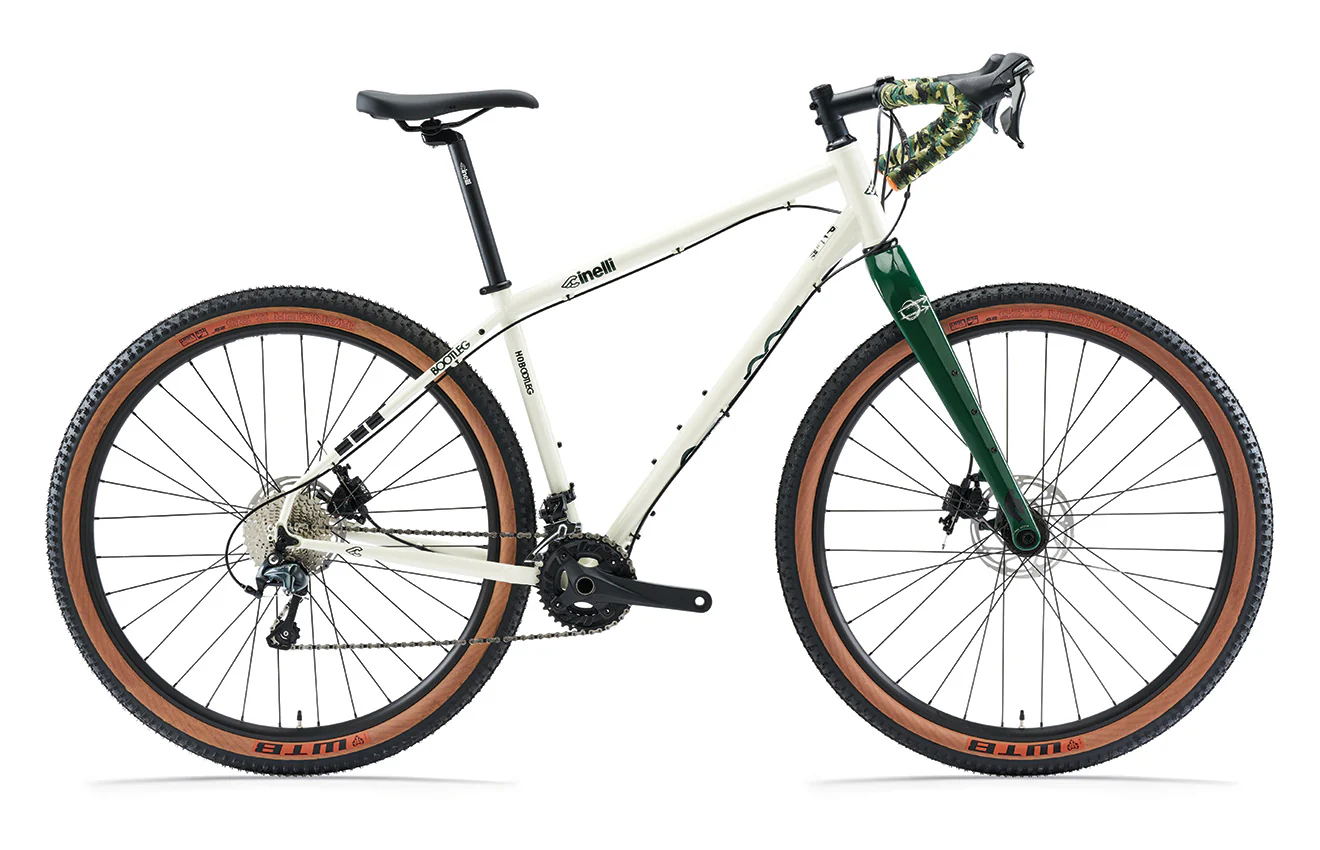
Italian Adventure Engineering Meets Technical Single-Track Capability
An aggressive off-road adventure bike with mountain bike-inspired geometry, designed for technical terrain and extreme tire clearance. Built from premium Columbus steel with modern components for the most demanding bikepacking adventures.
Price: $2,399 USD (about $3,760 AUD)
Weight: 12.9kg (28.4 lbs)
Frame/Fork Material: Frame – Columbus Cromor Triple-Butted Steel. Fork – Columbus Futura Adventure Carbon Tapered
Groupset & Drivetrain: Shimano Tiagra/Deore mix, 36/26t crank and Shimano 11-34t 10-speed cassette
Gear Ratios: 20.69″ to 88.23″ (0.75 to 3.19 ratio)
Geometry (M): Stack/Reach ratio – 1.7:1 (644mm/379mm), chainstay 450mm – wheelbase 1,098mm – (steering) headtube angle 69° – trail 87.8mm (very high) – bottom bracket drop 70mm
Tires and Wheel Sizes (Tire Clearance): 29″ x 2.25″ with max tire clearance up to 29×3.0″ or 27.5×3.0″ (clearance with fenders varies)
The Cinelli HOBOOTLEG GEO represents years of dialogue with extreme adventurers, resulting in their most advanced adventure bike ever. This isn’t your typical touring bike – it’s a technical single-track destroyer that happens to excel at long-distance adventure riding.
Born from collaboration with BeCycling (who provided 8,000km of real-world testing), the HOBOOTLEG GEO draws heavily from mountain bike geometry with an upright riding position, long trail, and high bottom bracket for pedal clearance over obstacles. The geometry is inspired by mountain biking, with a sloped top tube, high figure trail, suspension-corrected fork, and clearance for plus tires.
The bike’s standout feature is its extreme tire clearance – accommodating tires up to 29×3.0″, making it more of a “Plus bike” than traditional gravel. This massive clearance, combined with boost hub spacing, allows riders to switch between 29×2.0″ for faster rolling and 27.5×2.8″+ for maximum traction and comfort.
Unlike traditional touring bikes that feel “like a train on tracks,” the HOBOOTLEG GEO is responsive to handlebar maneuvers, bends easily with weight shifts, and makes dodging rocks much easier. The premium Columbus Cromor steel frameset provides the perfect balance of compliance and durability, while the carbon fork with six eyelets offers exceptional front-loading flexibility.
The return to a 2x drivetrain (after experimenting with 1x in previous iterations) shows Cinelli’s commitment to real-world usability over trends. The 36/26t chainrings paired with an 11-34t cassette provide a more practical gear range for loaded touring compared to the ultra-wide single-ring setups.
This bike excels in hybrid bikepacking setups rather than traditional four-pannier configurations. With space for five bidon cages and eyelets for front/rear racks and fenders, it’s perfectly equipped for modern adventure cycling where gear is distributed across frame bags, fork cages, and minimal panniers.
The HOBOOTLEG GEO isn’t for everyone – it prioritizes technical capability over pure touring comfort, and the oversized tires mean higher rolling resistance on pavement. But for riders tackling demanding terrain from African washboard to Rocky Mountain single-track, few bikes match its combination of Italian craftsmanship, extreme versatility, and technical prowess.
A sophisticated adventure weapon that transforms rough terrain into rideable routes, backed by premium Italian engineering and real-world testing from some of cycling’s most extreme adventurers.
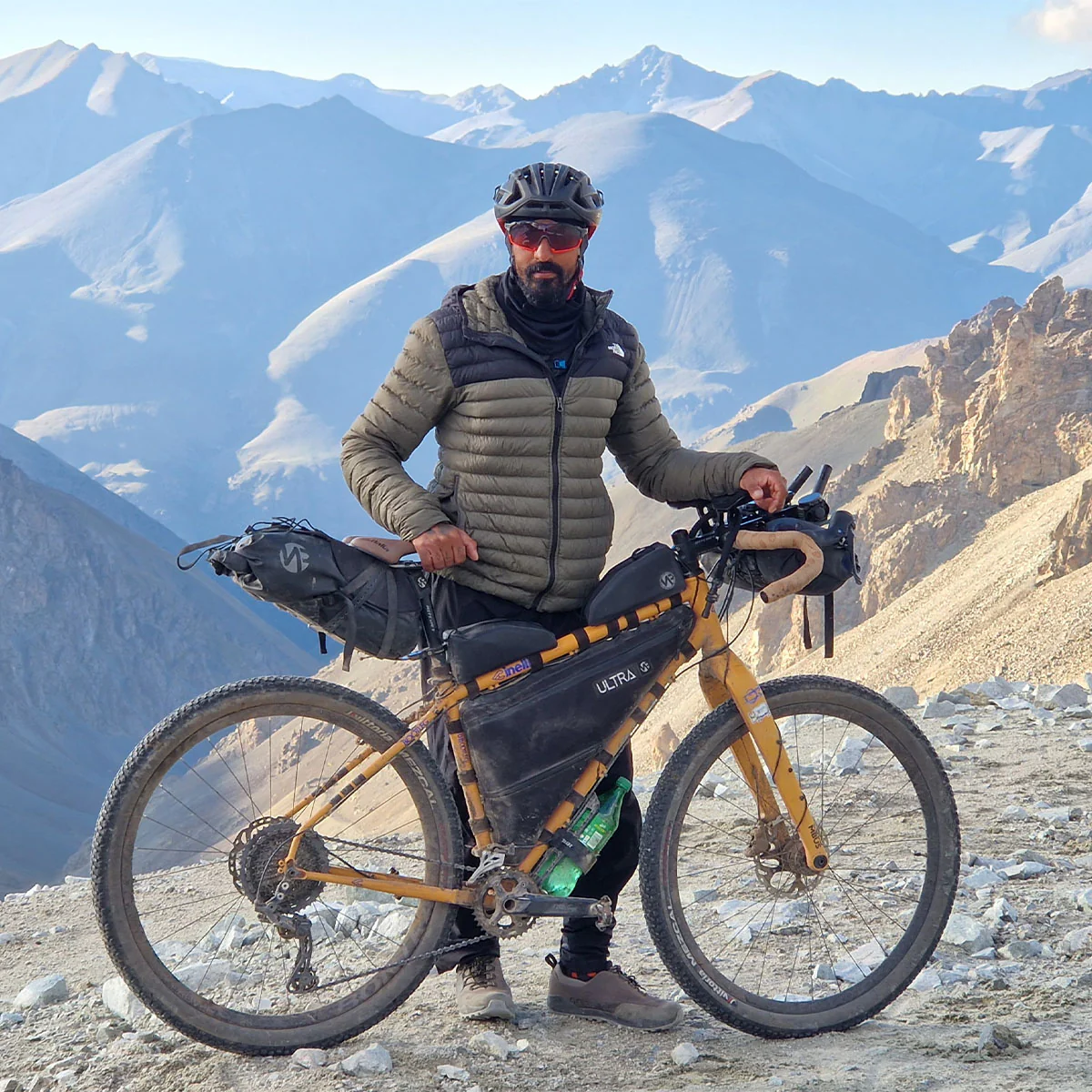
Cinelli HOBOOTLEG GEO is a premium Columbus Cromor steel adventure bike with mountain bike-inspired geometry and clearance for massive 29×3.0″ or 27.5×3.0″ tires. Designed for technical singletrack and demanding bikepacking, it pairs a carbon Columbus Futura Adventure fork with a practical Shimano 2×10 drivetrain for real-world touring versatility. With extensive mounts, boost hub spacing, and stability-focused geometry, it’s built to tackle everything from rugged mountain passes to multi-continent expeditions.
Genesis Croix De Fer 50
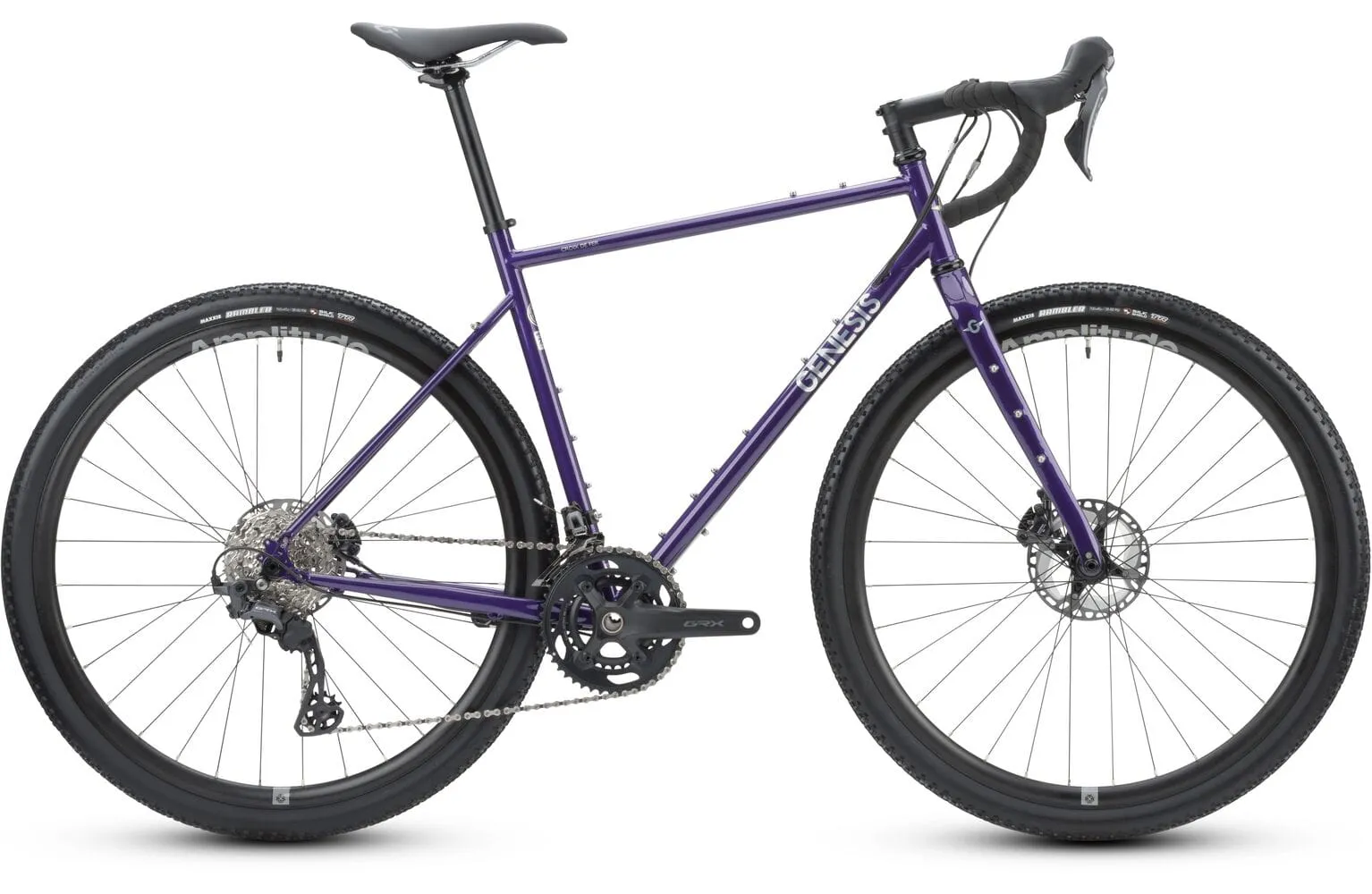
The Ultimate Steel Adventure Bike with Premium GRX Components
A do-it-all steel gravel machine built with Reynolds 725 frameset, carbon fork, and Shimano’s top-tier GRX groupset. Ready for bikepacking, commuting, and epic off-road adventures
Price: £2,599 GBP (about $3,200 USD / $5,040 AUD)
Weight: Approximately 11.5kg (25.3 lbs)
Frame/Fork Material: Frame – Reynolds 725 Steel. Fork – Genesis Carbon with rack mounts
Groupset & Drivetrain: Shimano GRX RX820 2×12-speed, 46-30T chainrings with Shimano HG710 11-36T cassette
Gear Ratios: 22.5″ to 112.5″ (0.83 to 4.17 ratio)
Geometry (M): Stack/Reach ratio – 1.58, chainstay 445mm, wheelbase 1,070mm, headtube angle 71°, Bottom bracket drop 70mm
Tires and Wheel Sizes (Tire Clearance): 700c x 45mm Maxxis Rambler Tubeless Ready, with clearance for up to 50mm+ tires
The Genesis Croix De Fer 50 represents the pinnacle of the legendary Croix De Fer lineup, combining the best of modern gravel technology with Genesis’s renowned steel craftsmanship. Built with a Reynolds 725 steel frameset and carbon fork, this bike delivers exceptional durability while remaining surprisingly light.
What sets the CdF 50 apart is its premium component specification. The Shimano GRX RX820 2×12-speed drivetrain provides unmatched versatility for any terrain, while the hydraulic disc brakes offer precise stopping power in all conditions. The bike comes equipped with tubeless-ready Maxxis Rambler 45mm tires on Amplitude G-100 wheelsets, providing excellent grip and the option to run lower pressures for improved comfort.
The bike’s versatility truly shines with its comprehensive mounting options. Multiple mount points include rack and guard mounts, Anything Cage fork mounts, and a third bottle mount, making it an ideal choice for bikepacking adventures or daily commuting with cargo needs.
Genesis has refined the geometry over the years, and the current iteration strikes an excellent balance between stability and agility. The Reynolds 725 steel provides that coveted steel ride quality – smooth, compliant, and confidence-inspiring – while the carbon fork helps reduce overall weight and road buzz.
The 2025 model features significant improvements including 12mm thru-axles front and rear, plus enhanced tire clearance compared to previous generations. This makes it more capable than ever for serious off-road adventures while maintaining its reputation as an excellent road touring machine.
The Croix De Fer 50 sits at the top of the range for good reason. While Genesis offers more affordable options in the CdF lineup, the 50 model’s premium GRX components, carbon fork, and Reynolds 725 frame make it a bike that can truly handle anything you throw at it – from daily commutes to multi-day bikepacking expeditions across varied terrain.
For riders seeking a premium steel adventure bike that doesn’t compromise on modern performance, the Genesis Croix De Fer 50 delivers on all fronts. It’s a machine built for those who understand that the journey is just as important as the destination.
Stayer Groadinger UG
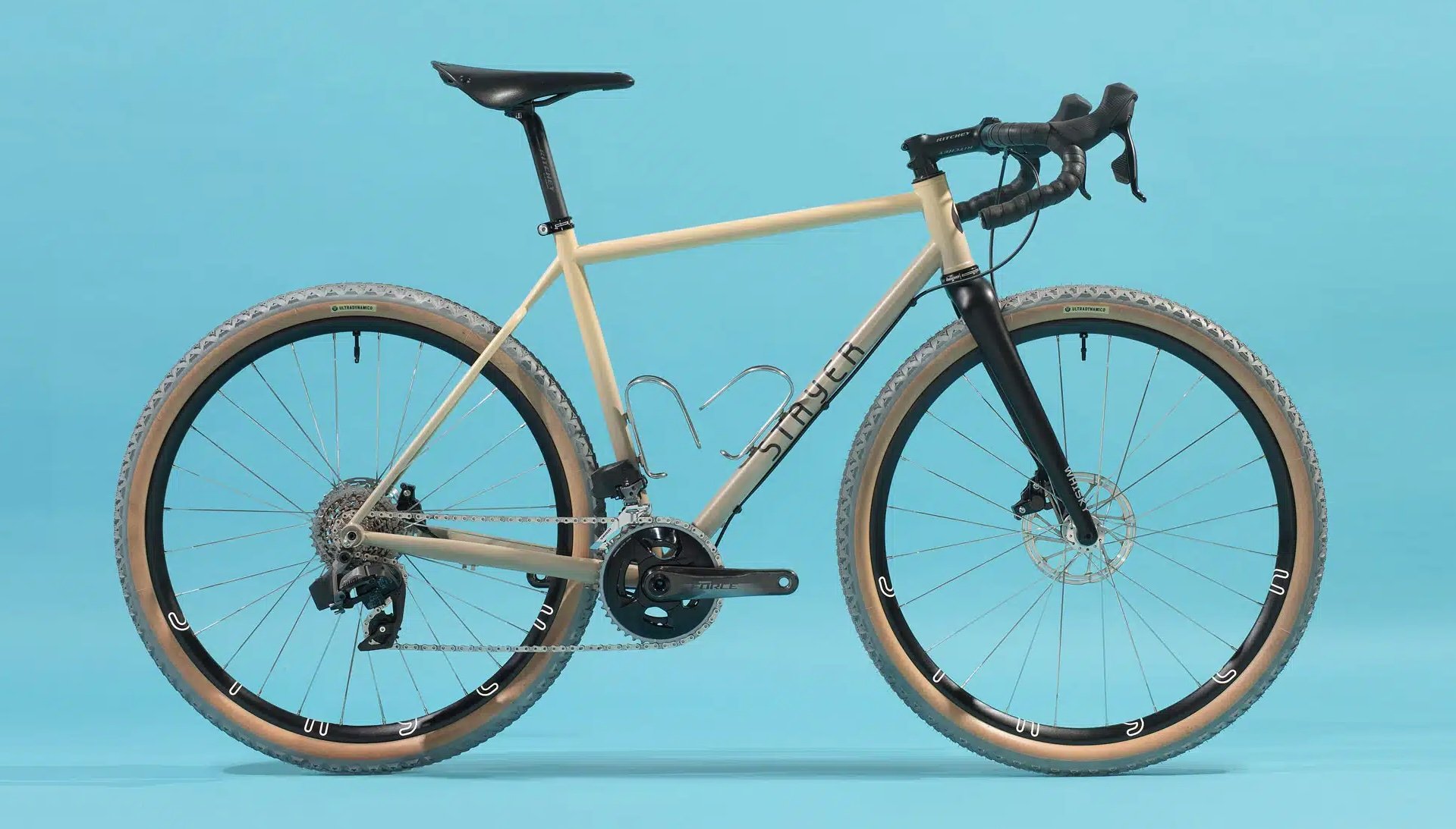
A Handcrafted Steel Adventure Machine Built for UK Gravel Conditions
Premium Columbus steel construction with massive tire clearance and adventure-ready versatility. Designed specifically for the ‘road-to-gravel-to-gnar’ ratio found in UK riding conditions.
Price: $2,047 USD (about $3,210 AUD) – frameset only
Weight: Not specified (frameset)
Frame/Fork Material: Frame – Columbus Zona TIG-welded steel. Fork – Carbon (Ritchey ADV recommended)
Groupset & Drivetrain: Compatible with 1x or 2x setups, external routing for mechanical or ETAP
Gear Ratios: Varies by build – designed for UDH compatibility
Geometry (M): Stack/Reach ratio – 1.49:1, chainstay 425mm – wheelbase 1,021mm – (steering) headtube angle 71.5 deg – trail 68.2mm – Fork offset/rake 48mm. Bottom bracket drop 68mm
Tires and Wheel Sizes (Tire Clearance): 650b x 2.1″ or 700c x 45mm maximum tire clearance
The Stayer Groadinger UG stands out as a testament to modern British steel craftsmanship, addressing the specific commenter question about steel bikes equipped with UDH compatibility sold as framesets. While the standard model comes with a traditional derailleur hanger, the frameset includes a rear mech hanger that can potentially be upgraded to UDH for mullet builds with T-Type transmission derailleurs.
Handmade in small batches at their Leytonstone, East London workshop, this bike embodies the boutique steel frame renaissance. The blend of Columbus ZONA and LIFE and T45 tubing creates a frame that’s both lightweight and incredibly durable. The Columbus steel soaks up road buzz while maintaining the stiffness needed for efficient power transfer.
The massive tire clearance sets this apart from many competitors – 2.1″ x 650b or 45mm x 700c opens up serious off-road capability. The frame includes three bottle cage mounts (top and bottom of down tube, plus seat tube), making it perfect for bikepacking adventures. The T47 threaded bottom bracket shell ensures creak-free performance and easy maintenance.
When you start really cranking the pedals, the Stayer Groadinger UG certainly goes, proving that steel doesn’t mean slow. The Groadinger UG ploughs through and over most rough terrain with huge confidence and agility, all while feeling incredibly comfortable. The geometry strikes a balance between the race-focused original Groadinger and all-day comfort for long adventures.
While not equipped with UDH from the factory, the frameset’s modern 142x12mm thru-axle rear end and inclusion of a derailleur hanger makes it a potential candidate for UDH upgrades, addressing the commenter’s interest in mullet builds with T-Type transmission systems.
Available in rAwrAw finish standard, with custom house finishes including Swamp Dip, How Now, and Chillymanilly, plus full RAL color customization. The small-batch, handmade approach means each frame receives individual attention from the London-based team.
A premium steel option that delivers both heritage craftsmanship and modern performance, perfectly suited for riders who want a bike that can handle everything from daily commutes to multi-day gravel adventures.
Bombtrack HOOK EXT
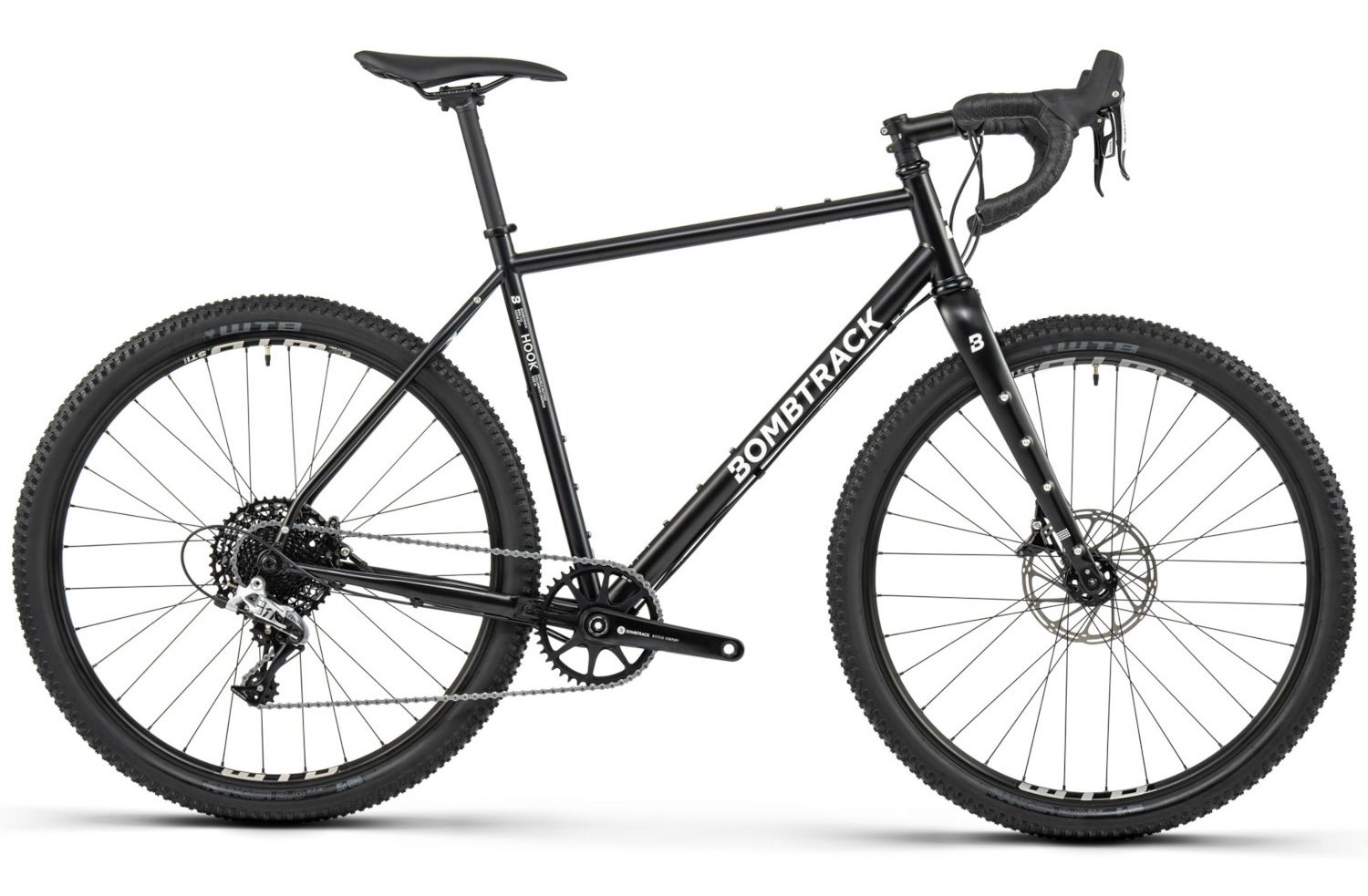
A Versatile Off-Road Explorer with Steel Soul and Modern Performance
The Bombtrack HOOK EXT represents the perfect marriage of traditional steel craftsmanship and modern gravel bike innovation. Built for riders who refuse to be confined to tarmac, this aggressive all-roader thrives where the pavement ends and adventure begins.
Price: $2,799 USD (approximately $4,388 AUD)
Weight: 11kg (24.2 lbs) for medium frame
Frame/Fork Material: Frame – Columbus Cromor Double-Butted Steel. Fork – Seido MGV Carbon with Triple Cage Mounts
Groupset & Drivetrain: SRAM Rival 1x Hydraulic, 40T direct mount chainring with 11-42T cassette
Gear Ratios: 26.1″ to 98.8″ (0.95 to 3.59 ratio)
Geometry (M): Stack/Reach ratio – 1.56, chainstay 425mm, wheelbase 1,034mm, head tube angle 71.5°, trail 58.5mm, fork offset 53mm, bottom bracket drop 66mm
Tires and Wheel Sizes: 650B/27.5″ x 50mm (2.0″) WTB Ranger TCS tubeless-ready tires with clearance for aggressive off-road rubber.
The Bombtrack HOOK EXT is where versatility meets adventure-ready capability. This isn’t your typical gravel bike – it’s an off-road weapon that happens to excel on gravel too. Rolling on aggressive 27.5 x 2.0” WTB Ranger tyres, this is one very capable and exciting bike when you turn off the tarmac and head onto the trail.
What sets the HOOK EXT apart is its commitment to going where others fear to tread. The Columbus Cromor steel frame provides that classic steel ride feel – compliant, comfortable, and confidence-inspiring – while the modern geometry keeps things lively and responsive. The 1x SRAM Rival groupset simplifies shifting while providing a wide enough range for steep climbs and fast descents.
The bike’s party piece is undoubtedly its tire clearance and mounting options. New for 2024, we fitted a Seido MGV carbon fork offering triple cage and low rider mounts, internal dynamo routing, making this a true do-everything machine. Whether you’re planning a weekend bikepacking adventure or tackling technical singletrack, the HOOK EXT has the mounting points and clearance to accommodate your gear and terrain choices.
At a claimed weight of 11kg for a medium (a large is likely 300g more), the Bombtrack feels positively spritely, especially if you’re coming from a steel plus bike, making it surprisingly nimble for such a capable all-rounder.
The 650B wheel size with 2.0″ tires strikes an ideal balance between rollover capability and agility. This setup provides excellent traction on loose surfaces while maintaining the playful handling characteristics that make technical terrain fun rather than frightening.
For riders seeking a bike that can handle everything from commuting to bikepacking to aggressive trail riding, the HOOK EXT delivers exceptional versatility without compromise. It’s particularly suited to those who value the refined ride quality of steel but demand modern performance and capability.
The HOOK EXT represents Bombtrack’s philosophy perfectly: build bikes that encourage exploration and reward adventure. It’s a machine that whispers “what’s over that ridge?” every time you swing a leg over it, and more importantly, it has the capability to get you there and back with a grin on your face.
Surly Midnight Special
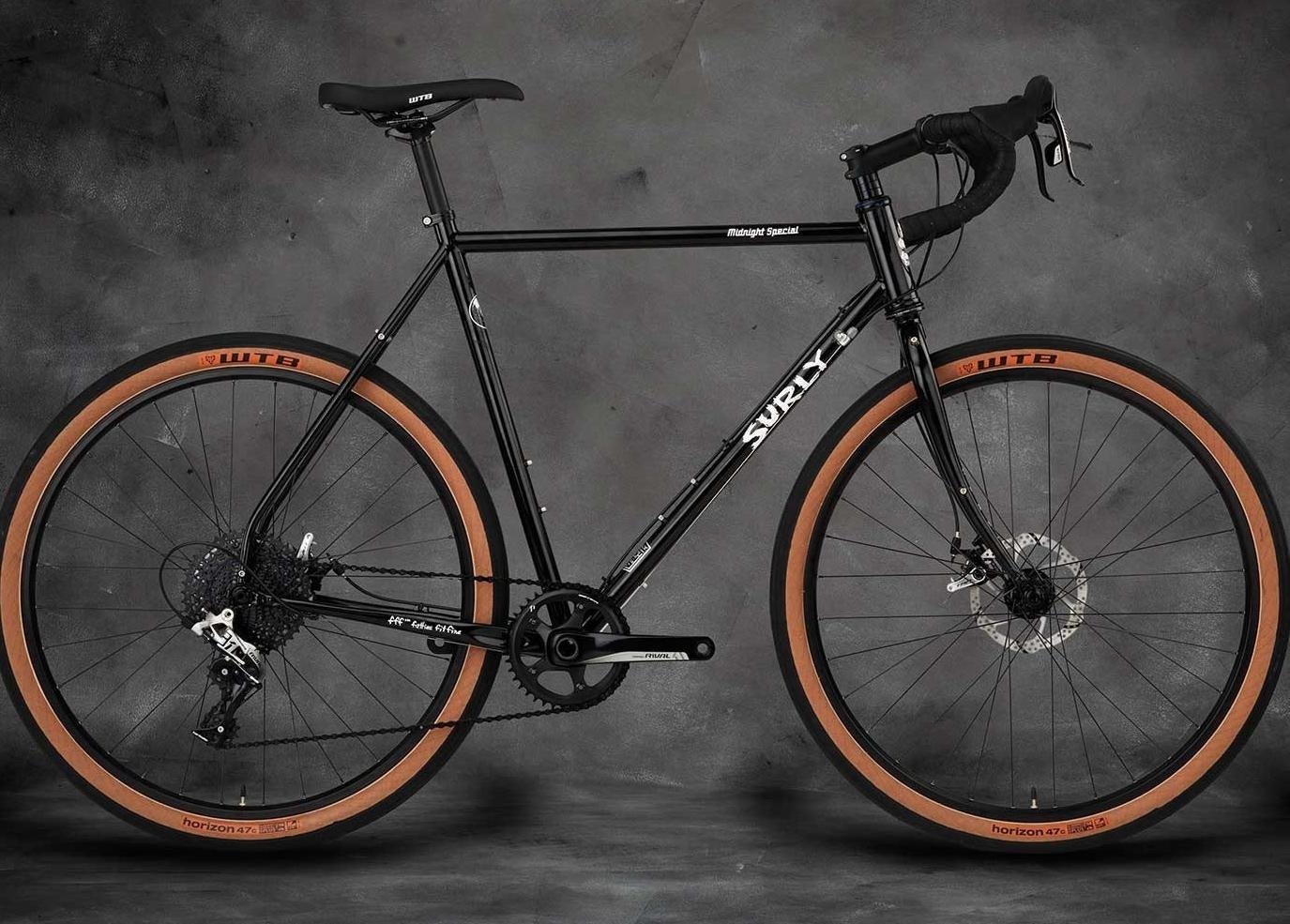
A Versatile Steel Gravel Machine Built for Adventure
The quintessential do-it-all steel bike that bridges the gap between road and gravel with classic Surly durability and modern versatility. Perfect for riders seeking a reliable companion that can handle everything from daily commutes to multi-day touring adventures.
Price: $2,199-$2,349 USD (depending on build specification)
Weight: 11.16 kg (24.6 lbs)
Frame/Fork Material: Steel/Steel – Surly 4130 Cromoly
Groupset & Drivetrain: SRAM Rival 1×11 with 40T crank and 11-42t SunRace cassette
Gear Ratios: 25.7″ to 98.2″ (0.93 to 3.56 ratio)
Geometry (56cm): Stack/Reach ratio – 1.48:1, chainstay 425mm – wheelbase 1,012mm – (steering) headtube angle 73° – trail 64.9mm – Fork offset/rake 40mm. Bottom bracket drop 65mm
Tires and Wheel Sizes (Tire Clearance): 650b x 60mm or 700c x 42mm without fenders – Ships with 700c x 38mm
The Surly Midnight Special represents the evolution of the all-road bicycle, combining classic steel frame construction with modern gravel bike geometry. What sets this bike apart is its exceptional versatility – it’s equally at home on smooth tarmac, rough gravel roads, and even light singletrack trails.
As detailed in our comprehensive Surly Midnight Special review, this bike excels where many others compromise. The steel frame provides the perfect balance of compliance and durability, soaking up road vibrations while maintaining the structural integrity needed for loaded touring or aggressive gravel riding.
The geometry strikes an ideal middle ground with a somewhat aggressive yet comfortable riding position. The 1.48:1 stack-to-reach ratio offers a more performance-oriented stance compared to traditional touring bikes, while the 425mm chainstays provide nimble handling without sacrificing stability when loaded with gear.
One of the Midnight Special’s greatest strengths lies in its tire clearance options. The ability to run either 650b wheels with up to 60mm tires or 700c wheels with 42mm rubber gives riders tremendous flexibility to optimize their setup for different terrain and riding styles. This adaptability makes it an excellent choice for cyclists who don’t want to be limited to a single riding discipline.
The SRAM Rival 1×11 drivetrain provides a clean, reliable setup with a gear range that covers most riding scenarios. While some may miss the top-end speed of a 2× setup, the simplicity and wide range of the 1× system more than compensates, especially for mixed-terrain riding where frequent shifting between terrain types is common.
When comparing the Midnight Special to its stablemate, the Surly Straggler, the key differences become apparent. The Midnight Special’s more aggressive geometry and modern tire clearances make it better suited for faster-paced gravel riding and all-road adventures, while the Straggler remains more touring-focused with its relaxed geometry and traditional rack mounts.
The build quality is quintessentially Surly – robust, practical, and built to last decades rather than seasons. The steel construction ensures this bike will age gracefully, developing character while maintaining structural integrity through years of hard use. The ability to accommodate both mechanical and hydraulic brake systems future-proofs the bike for component upgrades down the line.
At 11.4 kg for a complete steel bike, the weight is reasonable though not lightweight by modern carbon standards. However, the durability, repairability, and ride quality of steel more than justify the additional weight for most riders seeking a versatile, long-term cycling companion.
The Midnight Special shines brightest for riders who want one bike to do everything well – weekend gravel adventures, daily commuting, light touring, and even the occasional cyclocross race. It’s the perfect choice for cyclists who value versatility, durability, and the timeless appeal of a well-built steel bicycle over the latest trends in carbon fiber.
Marin Four Corners 2
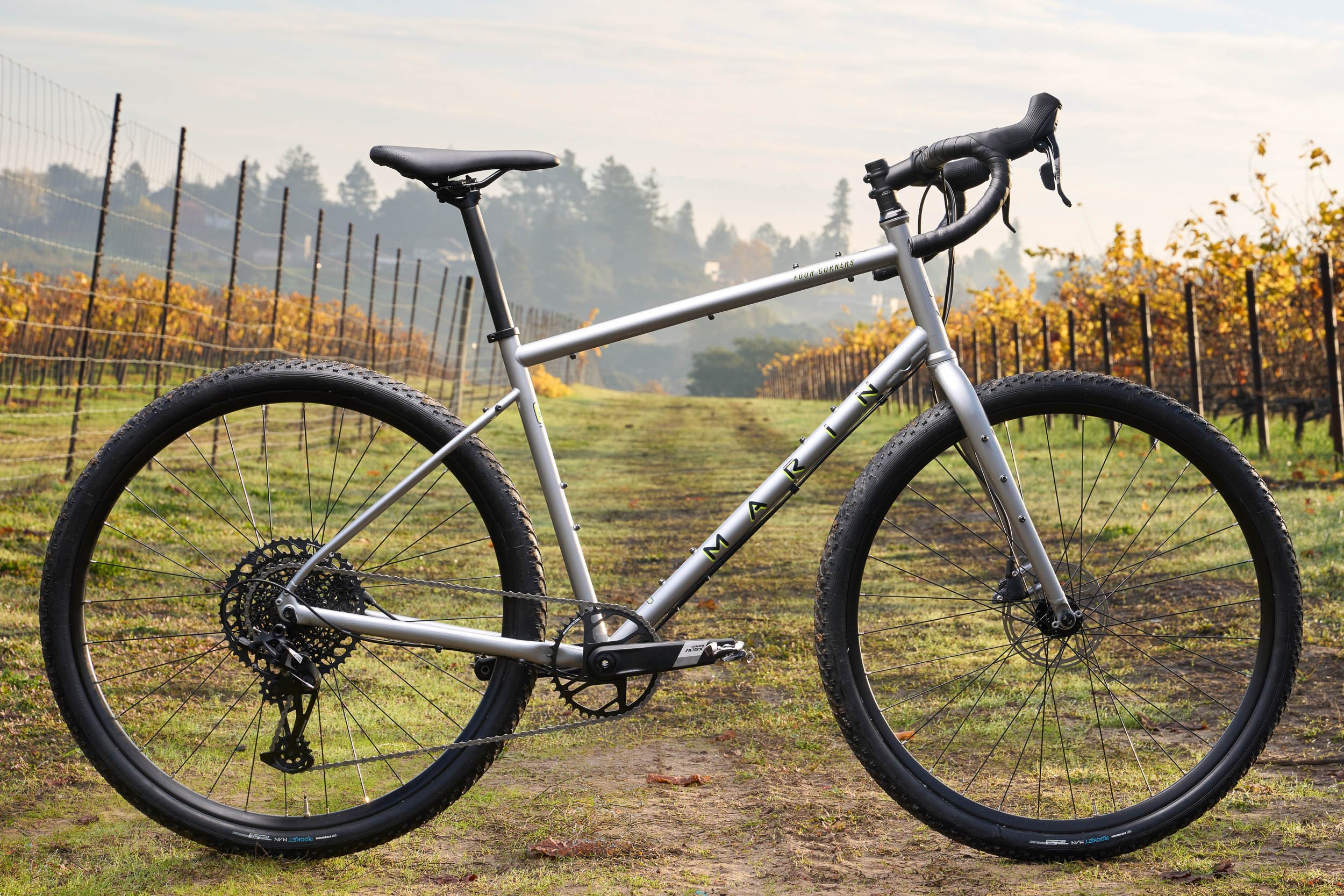
A Modern Steel Touring Machine with Gravel Bike Versatility
The perfect blend of classic touring DNA and contemporary gravel bike sensibility. Built with Series 3 double-butted CrMo steel frame and modern SRAM 1×12 drivetrain for adventure riders seeking reliability and comfort.
Price: $1,999 USD (about $2,699 CAN)
Weight: ~13kg (28.6 lbs) estimated
Frame/Fork Material: Frame – Series 3 Double Butted CrMo. Fork – Series 3 CrMo
Groupset & Drivetrain: SRAM Apex 1 12-Speed, 40T crank and SRAM CS-XG-1275 10-52T cassette
Gear Ratios: 20.8″ to 108.0″ (0.75 to 3.9 ratio)
Geometry (M): Stack/Reach ratio – 1.53:1, chainstay 450mm, wheelbase 1,087mm, (steering) headtube angle 70°, trail 77.1mm, Fork offset/rake 49mm. Bottom bracket drop 72mm
Tires and Wheel Sizes (Tire Clearance): 700c x 44mm (650B on XS/S sizes) with max tire clearance up to 50mm
The Marin Four Corners 2 represents everything that makes touring bikes special while embracing modern gravel bike technology. New for ’24, the Four Corners 2 takes all the elements that make the Four Corners fantastic and adds a Series 3 double-butted CrMo frameset, a simpler, wide-range SRAM 1×12 speed Apex drivetrain, making it a compelling choice for riders who want classic steel comfort with contemporary performance.
The drivetrain is the biggest upgrade. Instead of a Shimano Sora 3×9, the Four Corners 2 sports a SRAM Apex Eagle 1×12 drivetrain. The Apex was simple, versatile, and bulletproof. The wide-range 10-52T cassette paired with the 40T chainring provides ample gearing for both loaded touring and spirited gravel riding, eliminating the complexity of front derailleurs while maintaining gear range.
What sets this bike apart is its commitment to carrying capacity without sacrificing ride quality. We’ve included six bottle mounts, rack and fender eyelets, lowrider fork mounts, generous tire clearance, and disc brakes to set you up for all conditions and all terrain. This makes it genuinely capable of handling everything from daily commuting to multi-day bikepacking adventures.
The steel frameset provides the compliance and comfort that touring cyclists demand, while the geometry strikes an excellent balance between stability under load and nimble handling on varied terrain. A high front end creates all-day comfort and heads-up visibility; off-road-ready geometry means you won’t skip a beat when you head off the asphalt.
At $1,999, the Four Corners 2 sits in a competitive price bracket, but its steel construction, hydraulic disc brakes, and comprehensive mounting options provide exceptional value for adventure-focused riders. At an MSRP of $1,999, the Marin Four Corners 2 has a lot of competition in a very competitive gravel bike price category, yet it distinguishes itself through its touring-centric design philosophy.
The bike’s versatility shines whether you’re tackling rough backroads, commuting through the city, or embarking on multi-day adventures. The rubber meets the road/path/trail with wider, 44mm Vee Tire Quickstyx tubeless-compatible tyres, providing excellent traction and comfort across diverse surfaces.
A reliable, well-equipped steel machine that excels at bridging the gap between traditional touring and modern gravel riding. For riders seeking a bike that can handle anything from daily commutes to cross-country adventures, the Four Corners 2 delivers exceptional capability at a reasonable price point.
Marin Nicasio + and Nicasio 2
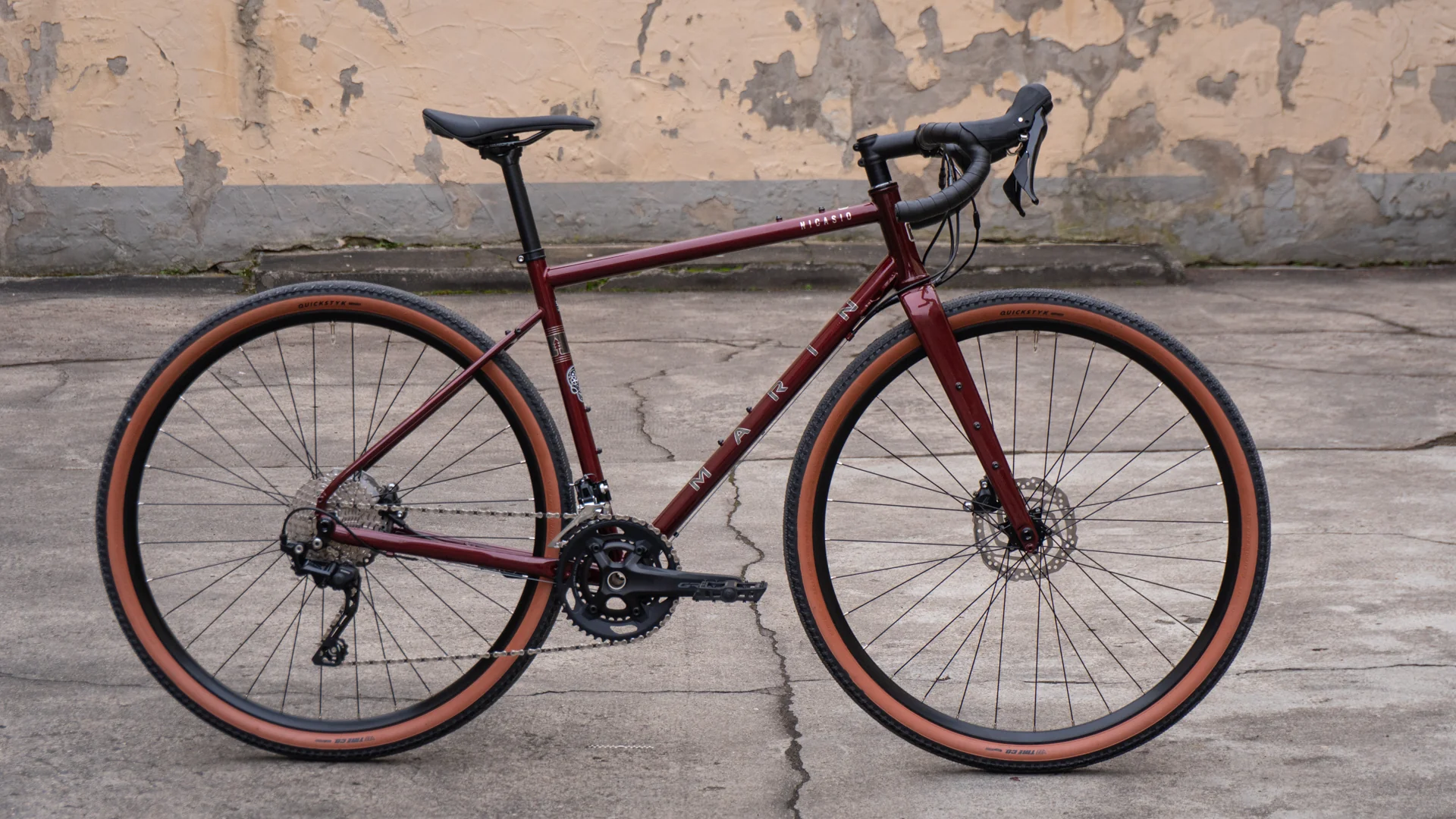
Budget-Friendly Steel Gravel Bikes for Different Riding Styles
Two steel-framed gravel bikes offering durability and comfort at different price points
Marin Nicasio + Price: $1,099 USD
Marin Nicasio 2 Price: $1,699 USD
Weight: Nicasio + 28.88 lbs (13.1 kg) | Nicasio 2 ~26-27 lbs
Frame/Fork: Both steel frames | Nicasio + steel fork | Nicasio 2 carbon fork
Groupset: Nicasio + MicroSHIFT Advent | Nicasio 2 Shimano Tiagra
Gear Ratios: Nicasio + 25″ to 105″ | Nicasio 2 27.4″ to 124.7″
Geometry (Medium): Stack/Reach 1.52 | Nicasio + 420mm chainstay | Nicasio 2 430mm chainstay
Tire Clearance: Nicasio + 700C x 40mm or 650B x 47mm | Nicasio 2 700C x 45mm
The Marin Nicasio lineup offers two approaches to affordable steel gravel riding. The Nicasio + delivers exceptional value as an entry-level steel gravel bike, perfect for newcomers or budget-conscious riders. The Nicasio 2 steps up with modern touches like hydraulic disc brakes and a carbon fork, appealing to riders wanting more refined performance.
Both share Marin’s quality steel frame construction, providing that smooth, comfortable ride steel enthusiasts love. The key difference lies in their components and intended use – the Nicasio + prioritizes value while the Nicasio 2 incorporates modern conveniences.
After testing the Nicasio +, it proves itself as a capable entry-level gravel bike. The 28.88-pound weight might seem heavy, but the steel frame delivers unmatched durability and smooth ride quality. The shorter 420mm chainstays create a somewhat jumpy rear feel that lacks supreme stability when loaded with gear, making it less ideal for hardcore adventures but perfectly adequate for most gravel riding.
The Nicasio 2 addresses these limitations with longer 430mm chainstays for improved stability, hydraulic disc brakes for better stopping power, and a carbon fork that reduces weight while improving vibration damping. The Shimano Tiagra components provide more refined shifting compared to the MicroSHIFT setup on the Plus.
Choose the Nicasio + if you’re new to gravel riding, prioritize value, or want a reliable bike for casual adventures. It’s one of the most affordable ways to enter steel-framed gravel riding.
Choose the Nicasio 2 if you want modern performance, plan longer adventures, or prefer refined components. The $600 price difference pays dividends in comfort and performance.
Both represent honest, well-executed approaches to affordable gravel riding, proving you don’t need premium pricing for quality steel-framed adventure cycling.
Why Ride Steel? (Are Steel Gravel Bikes Good?)
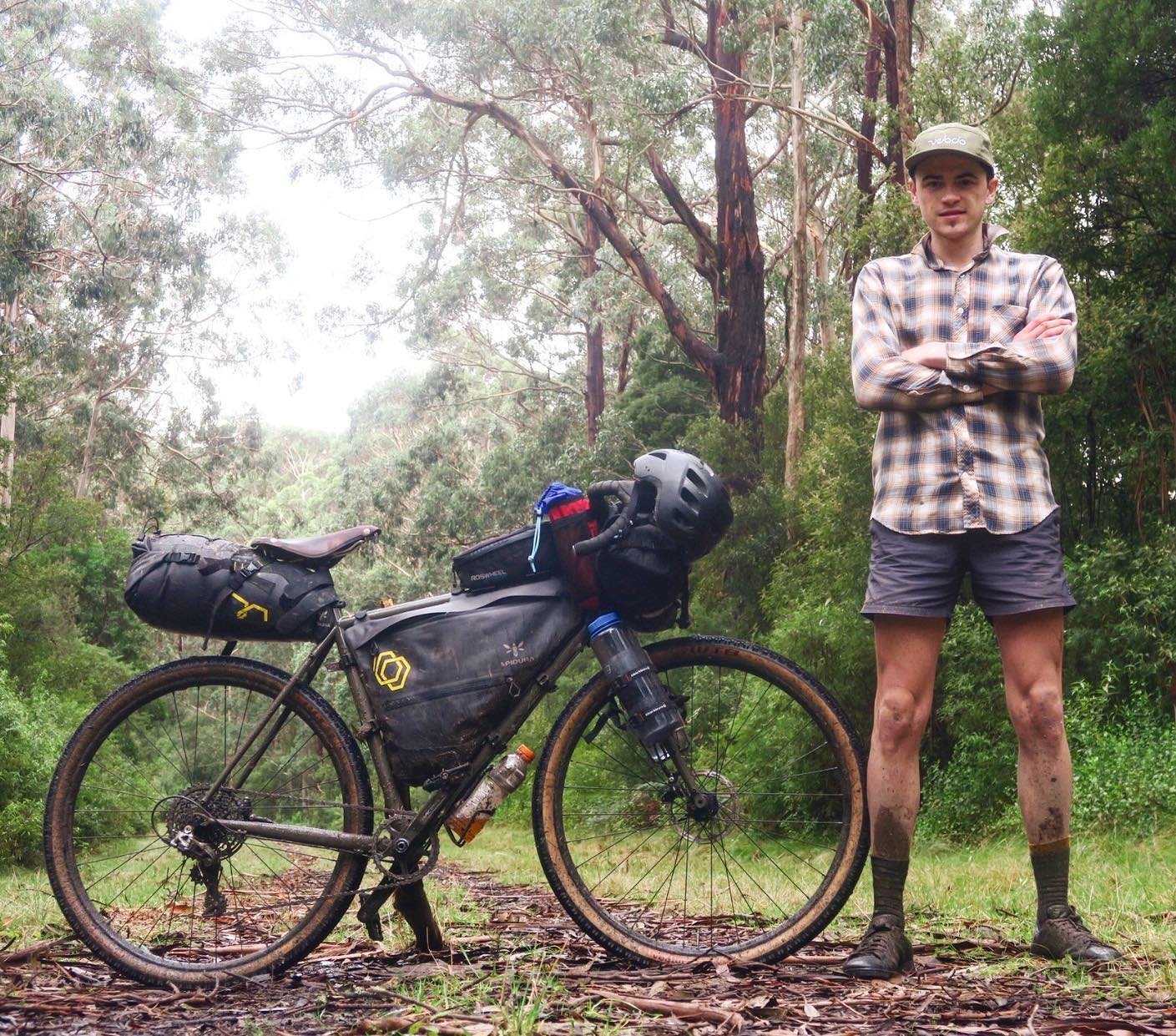
- Strength & Durability: Steel frames can handle heavy loads and tough conditions, perfect for adventure riding.
- Fatigue Resistance: High-quality steel is more fatigue-resistant and stiffer compared to titanium or aluminum, making it ideal for long-term use.
- Lightweight Modern Steel: Advances in steel technology mean modern gravel bikes are lighter than ever, with weights comparable to other materials.
- Slender Tubing Design: Allows for more space along the chainstay, improving bike aesthetics and functionality.
- Durability for Adventure: Steel frames can endure scratches, dents, and bends while remaining safe and rideable for years.
- Slow Failure Rate: Steel fails more slowly than other materials, offering a chance to address issues before they become dangerous.
- Ride Quality: Steel provides a smooth ride by dampening vibration better than aluminum, offering comfort and reducing shock to the rider.
- Modern Features: Many steel bikes now include carbon forks to reduce overall weight, enhancing handling and performance.
- Weight Comparison: Modern steel bikes are only slightly heavier than their carbon counterparts, a minor factor for adventure riders who value durability and comfort over minimal weight differences.
- Ideal for Adventure & Exploration: Perfect for riders who prioritize the journey and the experience over racing or speed.
Personally, I have a thing for steel bikes, and apart from having so much fun putting this article together. I have found there to be some really great benefits to opting for a steel-built bike!
Finding the perfect balance between cost, durability, and flexibility is where steel bikes truly shine. The hype surrounding steel bikes is well-founded – steel is real!
You would think that high-tech frame materials like carbon, aluminum, and titanium are taking the cycling scene by storm these days.
But I am happy that steel is still being used by adventure bike manufacturers, and they still see the importance of the old-school material.
In terms of volume, steel frames require less material compared to other materials, making them uniquely efficient. However, when considering weight, steel stands out as the heaviest option.
This paradox allows for steel frames to have exceptionally thin walls and smaller tube diameters.
Imagine compressing equivalent frames made of steel, titanium, aluminum, and carbon fiber into compact balls, devoid of any air space.
The steel frame, when condensed in this manner, would occupy the smallest volume, despite being the heaviest among them.
Steel bikes just have this certain “snap” – riding characteristic – about them, that is just different with other materials.
When I first got into exploring by bike, I was touring, and touring bikes are mostly made from steel due to the demands of generally carrying heavy loads and hauling all your gear.
You need a bike that has the strength for many days in the saddle.
Some of the better steel used for bike frames are more fatigue-resistant and stiffer for a given volume than titanium or aluminum.
This is why you may see some of the well-built steel bikes with slender tubing. Not all steel frame bikes are built with really skinning tubing, but for bikes like Surly, the slender design helps provide more valuable space along the chainstay between the tire and cranks.
Along with strength, steel bikes offer toughness or durability.
Making them built for adventure riding. You can scratch up, dint, and bend steel frames but still ride the bike for years and years.
This material is less affected by the abuse expected when you are out there on the trails. Also, steel fails relatively slowly, giving you a chance to fix a crack or a bend before it becomes dangerous.
Steel gravel bike weight was a downside for a while.
But I believe it is a thing of the past.
For example, I own the Kona Sutra LTD 2020, and when I was shopping around, and picked this thing up at the bike shop. I was so surprised by how light it was.
Now steel is not going to be as lightweight as carbon or potentially Titanium and Aluminum.
But it is up there with these materials nowadays! Most of the more modern steel gravel bikes are around the 10kg (22 pounds) to 13 kg (28.5 pounds) range. Thanks to the likes of thinner tubing.
Also, some of the bikes in this list have a carbon fork combo with a steel frame, which makes the overall weight lighter.
Also, with modern high-end, high-tech steel, the wall thickness can be as thin as a can of coke.
Furthermore, on weight, a steel bike probably weighs about 2-3 kg more than the equivalent carbon bike. And we are all about adventure riding more so than racing.
But if you are into bikepacking races or riding fast gravel. Steel still provides a viable option, with all the added accessories to your bike like pedals, body weight, other gadgets, bikepacking bags, and gear.
That little extra weight really would not matter too much. And certainly doesn’t matter to me as someone who is just out there to explore.
Recommended Article: Best Gravel Bikes For Touring!
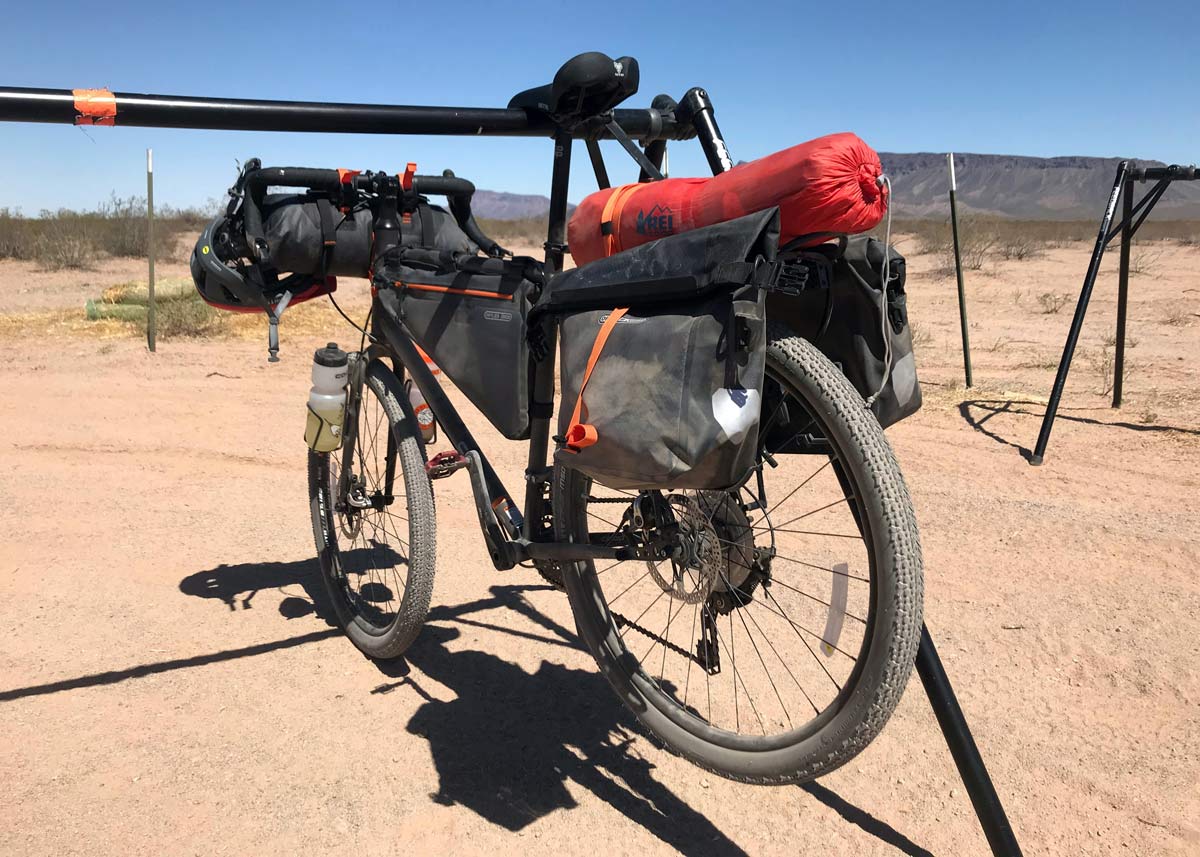
Then you have ride quality!
Many people who love steel will talk to you non-stop about how well it handles, even myself! Don’t get me started!
It’s as if it has a soul! Combing responsiveness and comfort all in one.
It’s this sensory responsiveness that you don’t often get with other materials that connect you to the bike and therefore your environment that much more.
Steel rides with stiffness, comfort, and liveliness. From experience with my 2020 model gravel/adventure bike, it glides over the really rough stuff like floating on clouds! Yes, along with the suppleness of chunky MTB tires.
Combined with a steel frame. That is strong and flexible, you experience comfort and it is rather easy on your joints.
Steel dampens vibration better than aluminum and doesn’t transmit as much shock through the frame to the rider, creating a smoother ride feel.
The Modernization of Steel Gravel Bikes
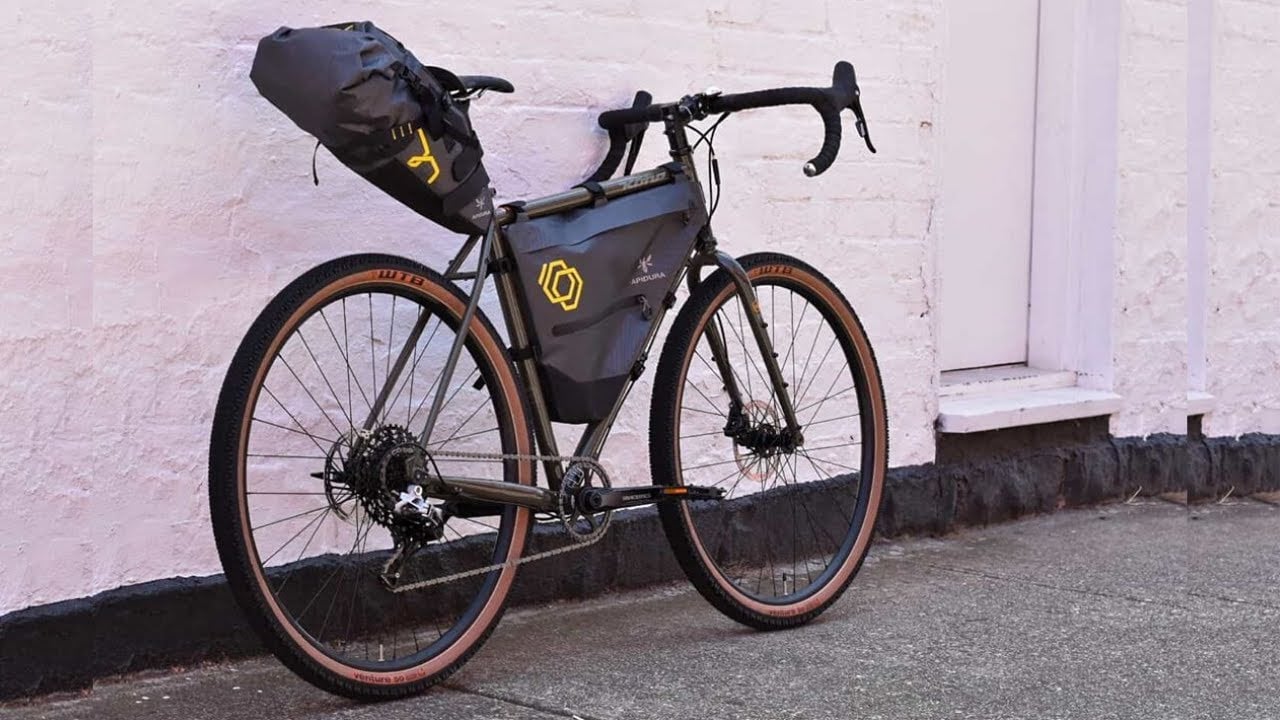
The landscape of steel as a material for bike frames underwent a significant transformation in the late 1990s, marked by the introduction of air-hardened steel tubesets.
This innovation began with the release of 853, followed by other notable alloys like OX Platinum, Spirit, and ThermLX. These advanced steel alloys boasted enhanced strength, allowing frame builders to utilize thinner tubing in the construction of bike frames.
The result was frames that were not only lighter but also more responsive to the rider’s input, transforming the riding experience.
As the evolution of steel continued, the industry saw the introduction of martensitic stainless tubesets such as 953, 931, and XCr.
These materials pushed the boundaries even further, offering even greater strength. However, their rarity has made them a less common sight in the market.
This leap in material science means that if you’ve ever ridden a steel frame and found it lacking, it’s worth noting that not all steel bikes are created equal.
The advancements in steel technology have significantly diversified the capabilities and performance of steel frames, especially in the realm of gravel biking.
Today’s modern steel gravel bikes are a testament to this evolution, combining the classic appeal of steel with cutting-edge engineering to meet the demands of the modern cyclist.
These bikes offer a blend of durability, comfort, and performance that is hard to match, making steel an ever-relevant choice in the construction of versatile and enduring gravel bikes.
Do steel gravel bikes fatigue?

In the exploration of steel bike fatigue, a comprehensive study detailed in the article “Fatigue life analysis of steel bicycle frame according to ISO 4210” by Tomasz Tomaszewski delves into the endurance of steel frames under operational loads.
This research is pivotal in understanding how steel, a material long revered for its resilience and flexibility, stands up against the rigors of cycling, particularly when juxtaposed with materials like carbon and aluminum, which are also prevalent in bike manufacturing.
The study focuses on a bicycle frame constructed from 25CrMo4 steel, a low-alloy steel alloyed with chromium and molybdenum, known for its excellent balance between mechanical properties, weight, and cost.
This material choice is instrumental in producing thin-walled tubes that offer high durability and reduced weight, making it a staple in bicycle frame construction.
Through high-cycle fatigue tests conducted on mini-specimens from both the joint material and the base material of the frame, the investigation aimed to quantify the fatigue life under real-world conditions.
These tests, aligned with the ISO 4210 standard, are designed to ensure the safety and reliability of bicycle frames by simulating the stresses and loads a bike would typically endure.
One of the study’s critical findings is that fatigue life is significantly influenced by the actual loading conditions a bicycle experiences.
The cyclic nature of these loads, particularly at structural nodes under heavy stress, can initiate fatigue cracks that compromise the frame’s integrity.
The analysis revealed that even with advanced steel alloys, the risk of fatigue failure exists, underscored by the detection of fatigue cracks at the connection between the top tube and the seat stays after three years of use in gravity mountain biking.
Comparatively, materials like carbon and aluminum offer different fatigue characteristics. Carbon frames, while lighter and able to be engineered for specific performance attributes, can be more susceptible to catastrophic failure upon impact due to their stiffness and the nature of carbon fiber.
Aluminum, on the other hand, provides a balance between weight and durability but may not offer the same level of fatigue resistance as high-quality steel, especially in the context of long-term stress and load-bearing.
The study’s utilization of finite element analysis (FEA) and probabilistic Weibull models to estimate fatigue life sheds light on the complex interplay between material properties, design choices, and real-world usage patterns.
It highlights the importance of considering mean stress effects and the size effect in fatigue evaluations, which are crucial for accurately predicting the longevity and reliability of steel bicycle frames.
In conclusion, while steel bikes exhibit a remarkable fatigue life, particularly with advancements in steel technology, they are not immune to fatigue failure.
The operational conditions and the forces exerted on the bicycle significantly impact the longevity of the frame.
This research underscores the necessity of meticulous design, material selection, and manufacturing processes to optimize the fatigue strength of steel bicycles, ensuring they meet the rigorous standards set forth by ISO 4210 and cater to the demands of modern cyclists.
Pros and Cons of Steel Gravel Bikes
Pros
- Ideal balance between cost, durability, and ride compliance
- In the event of damage, steel frames are much easier to repair than those made from materials like carbon fiber. Which is a major benefit for long bike trips. Ease of repairability is ideal with limited serviceability options on the road.
- By volume, steel frames use less material than those made from titanium, aluminum, or carbon fiber, showcasing unique material efficiency.
- Steel design allows for paper-thin tubing walls and smaller tube diameters, resulting in a compact volume.
- Boast a classic, timeless look! The aesthetic appeal, combined with modern manufacturing techniques, bridges the gap between tradition and contemporary performance. Perfect for those who have a connection to nostalgia.
- Manipulative material for custom bike builds. personalized geometry and design, catering to riders’ specific preferences and needs can be achieved with steel.
Cons
- Steel is a heavier material compared to titanium, alloy, and carbon. Can feel less agile and require more effort to pedal, especially on uphill climbs or when acceleration is needed.
- Limited availability might be a concern with steel bikes. Not always true, but high-quality steel frames, can be less readily available in mainstream bike shops and may require seeking out specialty manufacturers or custom builders.
Aluminum, Carbon or Steel? Which is best for a gravel bike?
Choosing the right material for a gravel bike boils down to comparing steel, carbon, and aluminum. Steel offers a smooth ride and timeless appeal but is heavier.
Carbon is lightweight and stiff, perfect for performance, though it can be costly and less durable upon impact.
Aluminum provides a middle ground with good durability and a lighter feel than steel, all while being more affordable.
This brief comparison highlights the key differences to help guide your choice for the ultimate gravel biking experience
| Feature/Aspect | Steel Gravel Bikes | Carbon Gravel Bikes | Aluminum Gravel Bikes |
|---|---|---|---|
| Weight | Cons: Typically heavier than carbon and aluminum. | Pros: Lighter than steel in general. | Pros: Lighter than steel but generally heavier than carbon. |
| Ride Feel | Pros: Offers a smooth, compliant ride due to natural damping qualities. Cons: Less stiff than carbon. | Pros: Can be engineered for specific stiffness and compliance. Cons: Some find it to have a less “lively” feel. | Pros: Stiffer than steel, offering precise handling. Cons: May transmit more road vibration. |
| Durability | Pros: Robust and can handle minor dings and impacts without structural compromise. | Cons: Can be damaged easily with sharp impacts. Damage might be invisible, leading to potential issues. | Pros: Durable and less prone to catastrophic failure than carbon. |
| Cost | Pros: Generally less expensive than carbon frames. Cons: High-end steel can be costly. | Pros: High performance-to-weight ratio. Cons: Typically more expensive. | Pros: Often more affordable than carbon, offering a good balance of cost and performance. |
| Repairability | Pros: Easier to repair with welding if damaged. | Cons: Difficult to repair, often requiring a replacement. | Pros: More challenging to repair than steel but easier than carbon. |
| Corrosion | Cons: Prone to rust if not properly cared for or if the paint is chipped. | Pros: Doesn’t rust or corrode. | Pros: Doesn’t rust like steel. Cons: Susceptible to corrosion if protective coatings are compromised. |
| Aesthetics | Pros: Classic, timeless look. Cons: Limited to tube-like shapes. | Pros: Allows for more innovative and aerodynamic designs. Cons: Some prefer the look of traditional materials. | Pros: Modern and sleek designs are possible. Cons: Some find the aesthetic less warm than steel. |
| Environmental Impact | Cons: Mining and processing of steel has environmental implications, though steel is highly recyclable. | Cons: Carbon production is energy-intensive and recycling is challenging. | Cons: Aluminum processing is energy-intensive, but the material is recyclable. |
| Modularity & Customization | Pros: Easier to make custom geometries and modify them. | Cons: Less modular; customization requires complex molds. | Pros: Allows for some level of customization, though not as flexible as steel. |
| Fatigue Life | Pros: Steel has an indefinite fatigue life if not corroded. | Cons: While carbon has a long fatigue life, it’s not as indefinite as steel. | Pros: Good fatigue life, but can be susceptible to stress cracks over time. |
Are steel gravel bikes slow?
The notion that steel gravel bikes are inherently slow is a misconception.
While it’s true that steel frames are generally heavier than their carbon or aluminum counterparts, the overall speed of a bike is influenced by various factors, including the bike’s geometry, tire rolling resistance, the rider’s efficiency, and the specific conditions of the ride and so many other variables.
Steel gravel bikes offer a unique blend of durability, comfort, and versatility, making them highly capable over a wide range of terrain.
The slightly increased weight of a steel frame can contribute to a steadier ride over rough surfaces, which can improve a rider’s average speed on gravel or mixed-terrain routes by enhancing control and reducing fatigue.
Additionally, the “springiness” or natural flex of steel can provide a more comfortable ride, allowing riders to maintain higher speeds for longer periods without discomfort.
In essence, while steel gravel bikes might not match the top-end speed of a lightweight carbon racer on smooth roads, they are by no means slow, especially in the context of gravel riding where comfort, stability, and endurance are equally important for maintaining a good pace.
Other Gravel Bike Articles You Might Be Interested In
Listed below is some more reading about gravel bikes if you are interested!
- Best Gravel Bikes Under $1000 in 2022
- Best Titanium Gravel Bikes 2022
- Best 22 Flat Bar Gravel Bikes In 2022
- Gravel Bike VS Touring Bike – What Is The Difference?
- 17 Lightest Gravel Bikes You Can Buy!
- Best Gravel Bike Clothing
About The Author
One thought on “Best Steel Gravel Bikes For Adventure Cycling – Everything You Need To Know!”
Comments are closed.

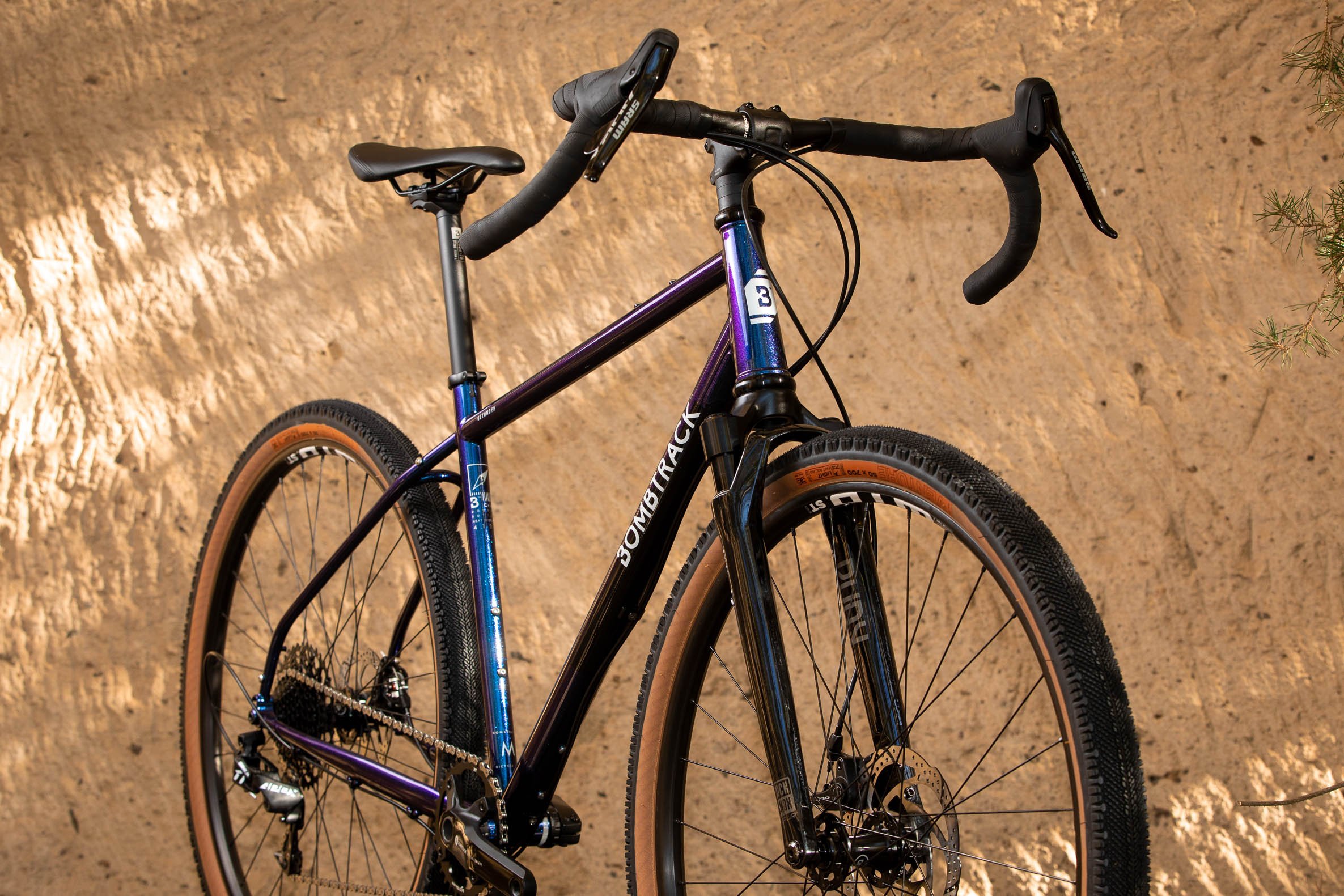

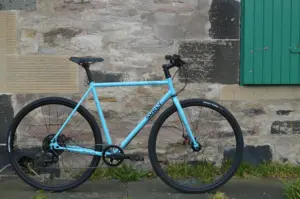
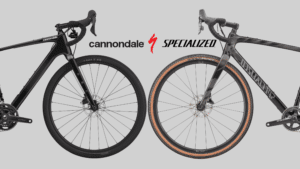
This a a very good brand from brasil, simple gravel bike, make whit care. https://dinamicabicicletas.com.br/guara.html